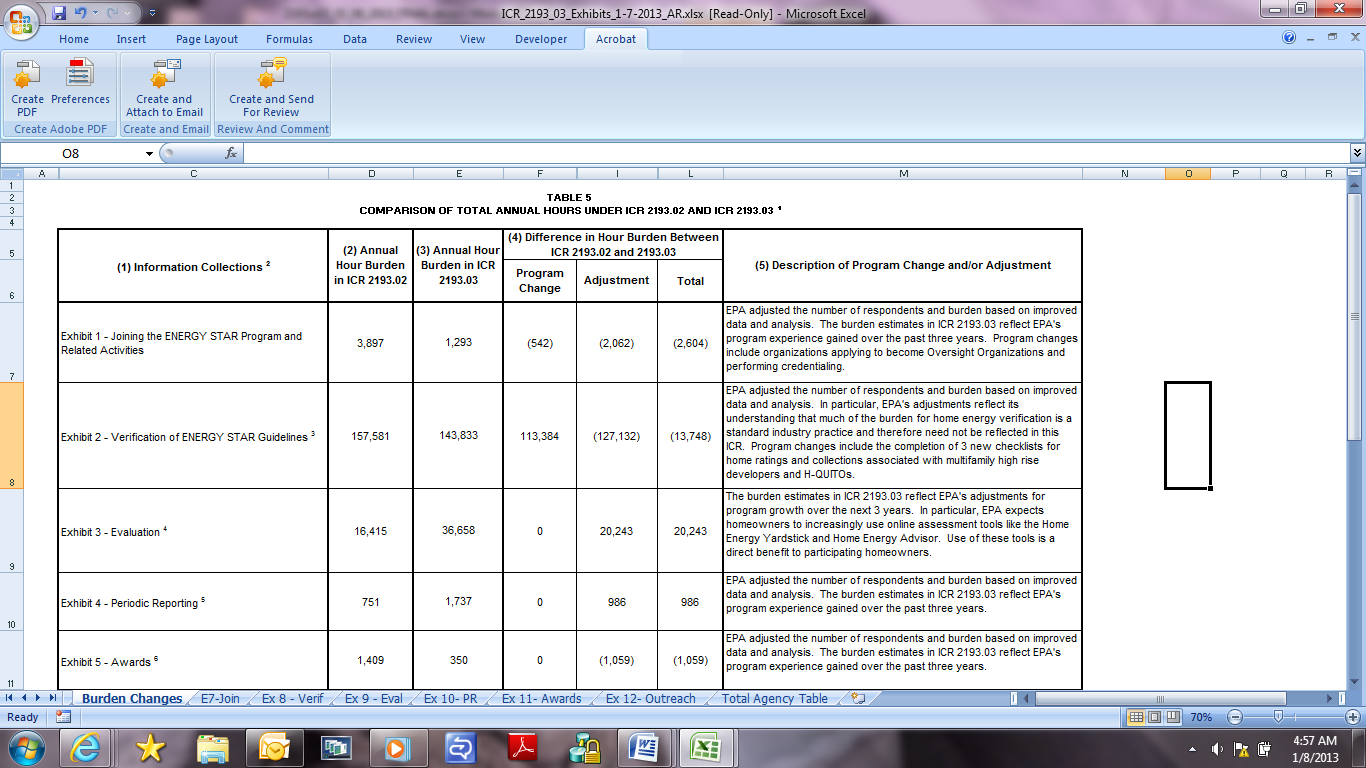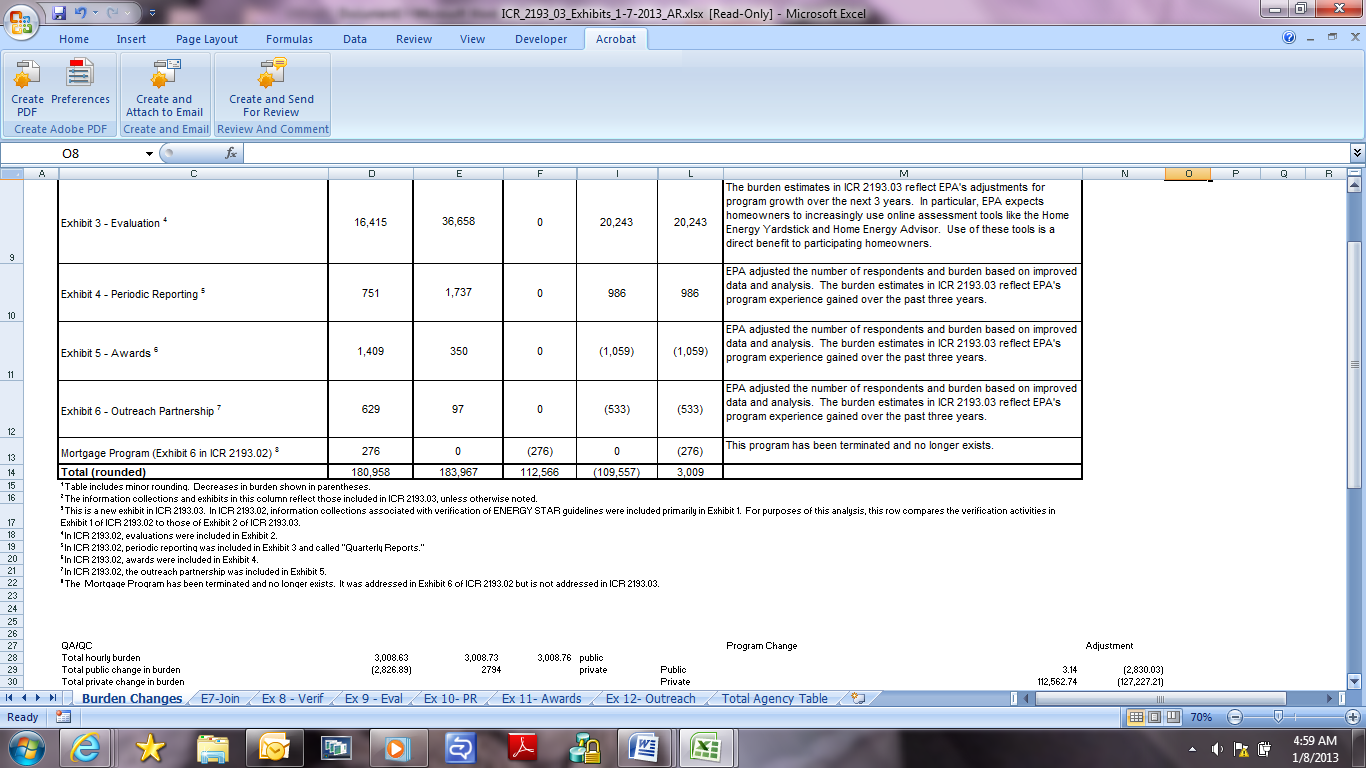ENERGYSTAR_Res_ICR_June 2014 FINAL_6 24 2014
ENERGYSTAR_Res_ICR_June 2014 FINAL_6 24 2014.docx
Energy Star Program in the Residential Sector (Renewal)
OMB: 2060-0586
SUPPORTING STATEMENT FOR
INFORMATION COLLECTION REQUEST RENEWAL NUMBER 2193.03:
“EPA’S ENERGY STAR® PROGRAM IN THE RESIDENTIAL SECTOR”
Prepared by:
Climate Protection Partnerships Division
Office of Air and Radiation
U.S. Environmental Protection Agency
TABLE OF CONTENTS
1. IDENTIFICATION OF THE INFORMATION COLLECTION 1
1(a) Title and Number of the Information Collection 1
1(b) Short Characterization or Abstract 1
2. NEED FOR AND USE OF THE COLLECTION 1
2(a) Need and Authority for the Collection 1
2(b) Practical Utility and Users of the Data 2
3. NONDUPLICATION, CONSULTATIONS, AND OTHER COLLECTION CRITERIA 7
3(b) Public Notice Required Prior to ICR Submission to OMB 8
3(d) Effects of Less Frequent Collection 9
4. THE RESPONDENTS AND THE INFORMATION REQUESTED 10
4(a) Respondents and SIC Codes 10
5(b) Collection Methodology and Management 31
5(c) Small Entity Flexibility 31
6. ESTIMATING THE BURDEN AND COST OF THE COLLECTION 31
6(a) Estimating Respondent Burden 31
6(b) Estimating Respondent Costs 31
6(c) Estimating Agency Burden and Costs 32
6(d) Estimating the Respondent Universe 32
6(e) Bottom Line Burden Hours and Cost Tables 57
1. IDENTIFICATION OF THE INFORMATION COLLECTION
1(a) Title and Number of the Information Collection
This ICR is entitled “EPA's ENERGY STAR® Program in the Residential Sector,” ICR number 2193.03, OMB Control 2060-0586. This ICR is a renewal and a non-rule related ICR.
1(b) Short Characterization or Abstract
ENERGY STAR® is a voluntary energy efficiency labeling program aimed at forming public-private partnerships that prevent air pollution rather than control it after its creation.
This ICR renewal covers information collection activities under the ENERGY STAR Program within the new home and existing home sectors. ENERGY STAR for new homes promotes energy efficient new home construction within the residential sector and ENERGY STAR for existing homes promotes cost-effective energy efficiency retrofits.
2. NEED FOR AND USE OF THE COLLECTION
2(a) Need and Authority for the Collection
Section 103(a) of the Clean Air Act authorizes EPA to establish “a national research and development program for the prevention and control of air pollution.” As part of such a program, EPA is to “conduct and promote the coordination and acceleration of research, investigations, experiments, demonstrations, surveys, and studies relating to the causes, effects (including health and welfare effects), extent, prevention and control of air pollution.” Section 103(a)(1).
In addition, as a component of the program, section 103(g) directs the Administrator to “conduct a basic engineering research and technology program to develop, evaluate, and demonstrate non-regulatory strategies and technologies for air pollution prevention.” The section calls on the Administrator to provide opportunities for industry, public interest groups, scientists, and other interested persons to participate in strategy development. Section 103(g) further directs EPA to include as elements in the program “improvements in non-regulatory strategies and technologies for preventing or reducing multiple air pollutants including sulfur oxides, nitrogen oxides, heavy metals, PM-10 (particulate matter), carbon monoxide, and carbon dioxide...” The strategies and technologies are to improve various air pollutant reduction and non-regulatory control strategies, including energy conservation.
The ENERGY STAR Program is one component of the Administrator’s response to reduce green house gas emissions that contribute to climate change. ENERGY STAR partners help promote efficient homes by building and labeling qualifying homes with the ENERGY STAR label and by improving the efficiency of existing homes. The label provides an easy way for consumers to identify energy-efficient homes and products that save money on utility bills and reduce air pollution. By using less energy, these homes and products help reduce the demand to create power, which is typically generated by power plants that burn fossil fuels. As such, these homes help reduce air pollutants such as sulfur oxides, nitrogen oxides, and carbon dioxide that are generated by these stationary sources. ENERGY STAR demonstrates how providing consumer information and public recognition can be used as a non-regulatory strategy to prevent and control air pollution.
The information collection activities described in this ICR are necessary for EPA to track and assess the market for energy efficient homes, which allows EPA to design its ENERGY STAR outreach programs and public education materials to fit the needs of its partners, as well as to provide public recognition and market differentiation to participating organizations. Because some of the collection activities involve small businesses, EPA will limit collection activities where a minimum amount of information is sufficient for EPA to complete its work.
2(b) Practical Utility and Users of the Data
This section identifies each of the information collection activities and documents included in this ICR, how EPA uses the information collected and, if applicable, how others use that information. Any forms that are new for this submission or revised since the last submission are identified via an asterisk (*), which is placed before the form’s title.
ENERGY STAR Certified Homes Program
Partnership Documentation
Home Builder / Home Energy Rater / Architect/Home Plan Designer, and Manufactured/Modular Homes Partnership Agreement (5900-188)
Energy Efficiency Program Sponsor Partnership Agreement (5900-33)
ENERGY STAR Certified Homes Energy Efficiency Program Sponsors / Energy Efficiency Program Sponsor Commitment Form (5900-272)
Lender Partnership Agreement (5900-08)
EPA uses information submitted in its ENERGY STAR Partnership Agreements for builders (5900-188), Homes Energy Raters (Raters) (5900-188), architects/home plan designers (5900-188), Manufactured/Modular Home Plants (5900-188), Energy Efficiency Program Sponsors (EEPS) (5900-33), and lenders (5900-08) to officially establish an organization’s participation in the ENERGY STAR Certified Homes program and to provide organizations with public recognition of their ENERGY STAR partnership. EPA uses the Partnership Agreement to enforce its trademark of the ENERGY STAR name and logos, to commit partners to verifying the energy efficiency of every home that receives an ENERGY STAR label, to provide public recognition by listing builder, Rater, and Sponsor, and lender partners on the ENERGY STAR Partner Locator (www.energystar.gov/partnerlocator) as well as committing partners to provide EPA with verification information upon request.
For builders, the Partnership Agreement provides the option of making a commitment to building 100 percent of their homes to ENERGY STAR Program Requirements, offering ENERGY STAR’s Advanced Lighting Package (ALP) in their homes, and/or offering EPA’s Indoor AirPLUS (IAP) label. These additional commitments can be made by the partner simply by initializing the applicable section of the Agreement. EPA will use information provided on the Partnership Agreement to provide public recognition to partners that are offering the Indoor AirPLUS in their new homes. EPA will also use this information to track the activities of builders building homes containing the IAP to make sure they are correctly implementing the IAP program.
Energy Efficiency Program Sponsors (EEPS) who are already partnered with another ENERGY STAR program can complete an “ENERGY STAR Certified Homes Energy Efficiency Program Sponsors / Energy Efficiency Program Sponsor Commitment Form” (5900-272) to add a Certified Home partnership to their list of ENERGY STAR partnerships rather than completing a separate Partnership Agreement. EEPS can only use the ENERGY STAR name and logos to promote program areas for which they have a Partnership Agreement.
Program Participation Documentation for Site-built Homes
*Thermal Enclosure System Rater Checklist (5900-176)
*Water Management System Builder Checklist (5900-178)
*HVAC System QI Contractor Checklist (5900-175)
*HVAC System QI Rater Checklist (5900-271)
The ENERGY STAR Certified Homes Inspection Checklists (5900-176, 5900-178, 5900-175, 5900-271) ensure that homes are built and verified to meet the Certified Homes Program requirements for energy efficiency. A credentialed HVAC contractor completes the “HVAC System QI Contractor Checklist,” which is then verified by a Rater using the “HVAC System QI Rater Checklist.” The builder completes the “Water Management System Builder Checklist” and the Rater completes the “Thermal Enclosure System Rater Checklist.”
The Inspection Checklists serve to protect the integrity of the ENERGY STAR program by providing independent, third-party verification of all ENERGY STAR certified homes. The information is not submitted to EPA but rather is maintained by the Rater and their oversight organization (called a Provider) and the homebuilder in the form of a home energy rating report, which is generated by either the Rater or the Provider. EPA may request a copy of the final rating report if there is a need to become involved in resolving questions concerning the ENERGY STAR status of a home.
Program Participation Documentation for Factory-built Homes
*Modular/Manufactured Home Plant Qualification Form (5900-194)
Manufactured Home Completion Report (5900-172)
*Modular Home Completion Report (5900-189)
For ENERGY STAR certified homes produced in a plant/factory (manufactured and modular homes), the manufacturing plants must ensure that they are ready and able to consistently produce homes that are ready for ENERGY STAR certification. A plant must be certified before it can produce ENERGY STAR certified manufactured or modular homes. Plant certification is managed by an EPA-approved manufactured and modular verification oversight organization (Systems Building Research Alliance - SBRA) and documented in the “Modular/Manufactured Home Plant Qualification Form” (5900-194). This form is not submitted to EPA but to the third party oversight organization. A copy must also be present on site at the plant itself. A Rater or plant representative completes the “Manufactured Home Completion Report” (5900-172) that verifies that a manufactured home was built on site to ENERGY STAR program requirements, and completes the “Modular Home Completion Report” (5900-189) that verifies a modular home was built to ENERGY STAR requirements. These forms are not submitted to EPA but rather to the third party oversight organization.
ENERGY STAR Multifamily High Rise Program
Partnership Documentation
MFHR Developer Participation Agreement (5900-267)
Energy Efficiency Program Sponsor Partnership Agreement (5900-33)
Energy Efficiency Program Sponsor Commitment Form (5900-272)
The ENEGY STAR Multifamily High Rise Program offers a Participation Agreement for multifamily developers (5900-267) and a Partnership Agreement for EEPS (5900-33). EEPS who are already partnered with another ENERGY STAR program can complete an “Energy Efficiency Program Sponsor Commitment Form” (5900-272) to add a Multifamily High Rise partnership to their list of ENERGY STAR partnerships rather than completing a separate Partnership Agreement. EEPS can only use the ENERGY STAR name and logos to promote program areas for which they have a Partnership Agreement. Please note that forms 5900-33 and 5900-272 apply to both the Certified Homes and the Multifamily High Rise Programs.
Program Participation Documentation
MFHR Project Application (5900-266)
MFHR Performance Path Calculator (5900-268)
MFHR Testing and Verification Worksheets (5900-269)
MFHR Submittal Validation Form (5900-270)
Developer partners must submit a “MFHR Project Application” (5900-266) for each multifamily mid and high rise project they would like to have considered for ENERGY STAR certification. The Project Application is submitted to EPA and includes basic information about the developer, the third-party Licensed Professional they have chosen to work with, and the building itself.
Developers can choose to follow either the Prescriptive Path or the Performance Path. If the developer selects the Performance Path, their Licensed Professional must submit a completed “Performance Path Calculator” (5900-268) on their behalf to EPA as part of their Proposed Design Submittal package (see below). The Performance Path Calculator reports the building’s energy modeling results to EPA who then confirms that these projections meet the Program Requirements for energy efficiency and building performance.
Regardless of the path chosen by the developer, the Licensed Professional will need to submit two packages of program documentation to EPA for review called the Proposed Design Submittal (PDS) and the As-Built Submittal (ABS). The former ensures that the building is designed to meet the Program Requirements and the latter documents the final inspection performed by the Licensed Professional.
Both the PDS and the ABS must include the “MFHR Testing and Verification Worksheets” (5900-269) to document the energy efficiency features in the building in both the design and post-construction phase. The Licensed Professional must also complete the “MFHR Submittal Validation Form” (5900-270) for both the PDS and the ABS to validate that all of the necessary program documentation is included in each submission.
Home Performance with ENERGY STAR Program
Partnership Documentation
HPwES Program Sponsor Partnership Agreement (5900-17/5900-176)
EEPS interested in sponsoring a Home Performance with ENERGY STAR (HPwES) program must complete an “HPwES Program Sponsor Partnership Agreement” (5900-176) to officially establish their participation in the HPwES program and to provide organizations with public recognition of their ENERGY STAR partnership. Contractors participating in HPwES programs are not ENERGY STAR partners, but must adhere to a participation agreement with the EEPS partner. This agreement describes the program’s requirements and terms of participation. EPA does not collect this information from Sponsors, but may ask to review their records to verify that Sponsors are properly overseeing the activities of contractors.
Program Participation Documentation
HPwES Program Plan Template (5900-186)
EPA will use the “HPwES Program Plan Template” (5900-189) prepared and submitted by EEPS partners to ensure that they have an effective plan to manage and consistently deliver a program for making whole-house energy efficiency improvements. EPA will also verify that key program components are included in the plan. EPA will refer to this plan when verifying a partner’s commitment to ENERGY STAR.
ENERGY STAR HVAC Quality Installation Program
Partnership Documentation
HVAC QI Program Partnership Agreement (5900-183)
Energy Efficiency Program Sponsors (EEPS) interested in sponsoring an ENERGY STAR HVAC Quality Installation (ESQI) program must complete an “HVAC QI Program Sponsor Partnership Agreement” (5900-183) to officially establish their participation in the ESQI program and to provide organizations with public recognition of their ENERGY STAR partnership. Contractors participating in ESQI programs are not ENERGY STAR partners, but must adhere to a participation agreement with the EEPS partner.
Program Participation Documentation
HVAC Installation Commissioning Report (5900-180)
Contractors participating in an ESQI program must complete an “Installation Commissioning Report” (5900-180) to document important verification information for each HVAC installation. EEPS collect and review a commissioning report for each installation to ensure the quality of the HVAC system with respect to ENERGY STAR’s Program Requirements for energy efficiency. EPA does not collect this information from EEPS, but may ask to review their records to verify that the Sponsor or quality assurance organization is actively reviewing reports.
Homeowner Data Collection Activities
Energy Use Authorization Form (5900-184)
Home Improvement Profile Form (5900-179)
EPA may, when granted permission by a homeowner who has purchased an ENERGY STAR certified home or had a Home Performance with ENERGY STAR project performed on their home, collect energy use and cost information from servicing utilities and energy suppliers. This information will be analyzed to determine the energy saving impact of the program. Partners complete the “Home Improvement Profile” (5900-179) to show the changes they have made and the results achieved. EPA may feature their profiles on the ENERGY STAR Web site so the public can learn from their accomplishments. Partners use the “Energy Use Authorization Form” (5900-184) to give written permission to their energy provider (e.g., electric, natural gas) to provide information to EPA for use in connection with the Agency’s evaluation of energy savings achieved through the Home Performance with ENERGY STAR program.
Outreach Partnership
Outreach Partnership Commitment Form (5900-06)
EPA may implement a public outreach campaign whereby the Agency develops and places public service announcements in trade and/or consumer media to increase the public’s awareness of energy efficiency and ENERGY STAR certified homes. Part of this campaign involves partners simultaneously developing and placing their own ENERGY STAR certified homes advertisements in the same trade and/or consumer media outlets. The information collected on the “Outreach Partnership Commitment Form” (5900-06) is used as an agreement between EPA and partners as to the terms of the outreach campaign to be co-developed. This includes the type of media to be used and the resources to be contributed by all partners towards the campaign.
Evaluation of Partners and Other Home Industry Professionals
EPA periodically contacts partners (e.g., by phone or email) to gather feedback about their experience with the program, and provide technical support, if necessary. EPA will use information collected from partners about their experience with the program to streamline and modify the program in order to improve participants’ experience and participation. EPA will use information collected from partners and others in the new home construction and home improvement sectors to evaluate the impact of ENERGY STAR on the building, selling, and promotion of energy efficient new homes and the improvement of existing homes.
In addition, EPA will use this information to improve its ability to serve the needs of those in the home construction and home improvement industries who wish to build and promote energy efficient homes. This collection activity will ensure that ENERGY STAR maintains its brand value in the marketplace as the symbol for energy efficient homes and products, and that its education and outreach efforts are well designed and targeted and properly executed given current market conditions. This evaluation information may also be used by EPA or shared with other organizations as part of public outreach or education campaigns promoting the environmental and economic benefits of energy-efficient new and existing homes.
Periodic Reporting
EPA asks partners to send periodic updates (e.g., quarterly emails) on accomplishments under the program. EPA will use the information obtained to learn about the progress and accomplishments of partners and others under the ENERGY STAR Program. For example, the quarterly emailed data help in the formulation of short- and long-term goals for energy and air pollution reduction and in the identification of partners who are deserving of special recognition via EPA’s ENERGY STAR Awards. This information is also used by EPA to inform the public as to the progress being made in reducing residential energy use and in reducing air pollution.
ENERGY STAR Awards
EPA evaluates partners in regard to their level of activity and brand support. Based on this assessment, EPA determines which partners will earn an ENERGY STAR award in the various award categories being offered. The awards themselves will be used by partners to promote their success as a partner and leader among their peers.
3. NONDUPLICATION, CONSULTATIONS, AND OTHER COLLECTION CRITERIA
3(a) Non-duplication
The information collected under this ICR does not duplicate any information that is collected by any other federal agency or otherwise publicly available.
3(b) Public Notice Required Prior to ICR Submission to OMB
EPA published a Federal Register notice on August 21, 2012 (77 FR 50495). No comments were received on this notice.
3(c) Consultations
EPA consulted with a few organizations outside the Agency to obtain their views on the information contained in this ICR, such as the respondent burden estimates, reasons for change in burden from the previously approved ICR, frequency of collection, and the utility/need for the data elements to be recorded, disclosed, or reported. The table below identifies the organizations contacted. They represent three of the major ENERGY STAR Partner types: home builders, home energy raters, and energy efficiency program sponsors.
Organization Name |
Organization Type |
Contact Person |
Feedback Date |
|
Meritage Homes |
Home Builder |
CR Herro |
5/17/14 |
|
DR Wastchak |
Home Energy Rater |
Daran Wastchak |
5/12/14 |
|
Southern Maryland Electric Cooperative (SMECO) |
Energy Efficiency Sponsor |
Jeff Shaw |
5/28/14 |
EPA provided a complete draft of the supporting statement to each organization for review and comment. EPA appreciates their feedback, as summarized below:
The contact person at Meritage Homes indicated that he had reviewed the ICR and found the burden estimates in Section 6 to be reasonable. He noted that the ICR assumes one out of seven production homes will be sampled for verification for the ENERGY STAR. This assumption is based on EPA guidance, which allows raters to sample one out of seven homes, as specified. Based on his experience, he suggested the ratio of production homes being inspected is more likely one out of four. EPA has carefully considered this input but continues to believe that the ICR’s current assumption is reasonable. As an initial point, EPA notes that Meritage Homes is a large production company and, as such, its input does not necessarily reflect the experience of small and medium-size firms. In addition, EPA re-iterates that its guidance allows for one out of seven homes to be sampled. The guidance has been widely distributed to ENERGY STAR Partners and others (e.g., via the web, etc.) and therefore EPA believes its procedures, recommendations, etc. are followed by much of industry.
The contact person at DR Wastchak indicated that he had reviewed the ICR, including the burden estimates in Section 6, and believes the ICR’s assumptions are reasonable.
The contact person at SMECO indicated that he had reviewed the ICR, including the burden estimates in Section 6, and believes the ICR’s assumptions are reasonable.
3(d) Effects of Less Frequent Collection
EPA has carefully considered the information collection burden imposed by the ENERGY STAR Program. EPA is confident that those activities requested of respondents are necessary, and to the extent possible, the Agency has attempted to minimize the burden imposed. EPA believes strongly that, if the information collections in this ICR are not performed at the requested frequency, EPA’s ability to implement the ENERGY STAR Program and the public’s ability to benefit from the program’s tools and resources could be hampered significantly.
3(e) General Guidelines
Information collections performed under this clearance will follow all of OMB's General Guidelines regarding federal data collection.
EPA intends to omit the expiration date from all forms being submitted for OMB review in this ICR. The information collected on the forms is modified infrequently. When modifications to the forms do occur, they normally involve changes that do not affect respondent burden (e.g., changes to wording and/or format). Under the 1995 Paperwork Reduction Act, a person is not required to respond to a collection of information unless it displays a currently valid OMB control number.
Since this ICR is renewed every three years, inclusion of an expiration date on the forms would require EPA to amend them every three years. This would create unnecessary burdens for both EPA and those who complete the forms. Since inclusion of the expiration date on the forms in these circumstances provides little to no value for the public, EPA intends to omit it from the forms under this ICR.
3(f) Confidentiality
Participation in the ENERGY STAR Program is voluntary and may be terminated by participants or EPA at any time. If a claim of confidential business information (CBI) is asserted, EPA will manage that information in accordance with EPA’s provisions on confidentiality. 40 CFR Part 2, Subpart B establishes EPA’s general policy on the public disclosure of information and procedures for handling CBI claims.
3(g) Sensitive Questions
No questions of a sensitive nature are asked of participants with ENERGY STAR.
4. THE RESPONDENTS AND THE INFORMATION REQUESTED
4(a) Respondents and SIC Codes
Respondents for this information collection request includes partners in ENERGY STAR, including homebuilders, verification organizations, lenders, utilities, and regional energy efficiency Program Sponsors. The following is a list of Standard Industrial Classification (SIC) codes and corresponding North American Industry Classification System (NAICS) codes for industry segments which may be affected by information collections covered under this ICR for the ENERGY STAR Program.
SIC NAICS Industries
1521 233320 General Contractors-Single-Family Houses
1522 233220 General Contractors-Residential Buildings, Other Than Single-Family Industry
1531 233210, Operative Builders
233310
1541 233310 General Contractors-Industrial Buildings and Warehouses
1542 233320 General Contractors-Nonresidential Buildings, Other than Industrial Buildings and Warehouses
1711 235110 Plumbing, Heating And Air-conditioning
1721 235210 Painting and Paper Hanging Industry Group
1731 235310 Electrical Work
1741 235410 Masonry, Stone Setting, and Other Stone Work
1742 235420 Plastering, Drywall, Acoustical, and Insulation Work
1743 235430 Terrazzo, Tile, Marble, and Mosaic Work Industry Group
1751 235510 Carpentry Work
1752 235520 Floor Laying and Other Floor Work, Not Elsewhere Classified
1761 235610 Roofing, Siding, and Sheet Metal Work Industry Group
1771 235710 Concrete Work Industry Group
1781 235810 Water Well Drilling
1791 235910 Structural Steel Erection
1793 235920 Glass and Glazing Work
1794 235930 Excavation Work
1795 235940 Wrecking and Demolition Work
1796 235950 Installation or Erection of Building Equipment, Not Elsewhere
1799 235990 Special Trade Contractors, Not Elsewhere Classified
4911 221122, Electric Services
221121
4922 486210 Natural Gas Transmission
4923 221210 Natural Gas Transmission and Distribution
4924 221210 Natural Gas Distribution
4925 221210 Mixed, Manufactured, or Liquefied Petroleum Gas Production and/or
4931 221112, Electric and Other Services Combined
221111,
221113,
221119
4932 221210 Gas and Other Services Combined
4939 221112, Combination Utilities, Not Elsewhere Classified
221122
4961 221330 Steam And Air-conditioning Supply
6021 522110 National Commercial Banks
6022 522190 State Commercial Banks
6029 522110 Commercial Banks, Not Elsewhere Classified
6035 522120 Savings Institutions, Federally Chartered
6036 522120 Savings Institutions, Not Federally Chartered
6061 522130 Credit Unions, Federally Chartered
6062 522130 Credit Unions, Not Federally Chartered
6111 522294 Federal and Federally-Sponsored Credit Agencies
6162 522390 Mortgage Bankers and Loan Correspondents
522292
6163 522310 Loan Brokers
6531 531320 Real Estate Agents and Managers
7389 541350 Business Services Not Elsewhere Classified
7623 811412 Refrigeration and Air-Conditioning Service and Repair Shops
8712 541310 Architectural Services
9531 925110 Administration of Housing Programs
9532 925120 Administration of Urban Planning and Community and Rural Development
4(b) Information Requested
The information collected by EPA differs depending on the specific collection activity as well as the respondent type. Therefore, this section describes the data items used and the associated respondent activities based on the respondent type within each major collection activity. [Note: For detailed information about the data items described in this section (e.g., elements on a specific form), refer to the forms submitted with this ICR.]
JOINING THE ENERGY STAR PROGRAM AND RELATED ACTIVITIES
Organizations interested in joining ENERGY STAR as partners are asked to submit a Partnership Agreement describing their commitment to promoting ENERGY STAR certified homes and residential energy efficiency. They also may be asked or encouraged to undertake related activities, as described below.
Home Builders
This participant group includes builders of traditional site-built homes such as large production home builders, custom home builders, and multifamily high rise (MFHR) developers. This group also includes onsite builders and installers of homes produced in manufacturing plants including manufactured and modular homes. This group also includes the manufacturing plants that produce manufactured and/or modular homes that, once fully constructed onsite, are eligible for the ENERGY STAR label. Organizations of all sizes are encouraged to join the Program by submitting a Partnership Agreement. Partners make a commitment to building and selling ENERGY STAR certified homes. In addition, when a builder joins, it can commit to build all of its homes to be ENERGY STAR certified (i.e., a “100% commitment”). If they choose to do so, they are asked to renew their 100% commitment annually. Further, MFHR developers are asked to submit a project application for each building/development project.
(i) Data Items
A Partnership Agreement and related materials.
Annual renewal of 100% commitment (optional).
For multifamily high rise developers, a project application for each building/development project.
(ii) Respondent Activities
To join ENERGY STAR, organizations are asked to complete and submit the Partnership Agreement and related materials online.
Partners choosing a 100% commitment renew their commitment annually online.
MFHR developers are asked to prepare and submit a project application for each building/development project.
Architects/Home Plan Designers
This partner group includes production architects and home plan designers who prepare architectural plans for residential construction projects. Organizations of all sizes are encouraged to join the Program by submitting a Partnership Agreement. Partners make a commitment to including energy efficient details on home plans in an effort to earn the Designed to Earn ENERGY STAR label.
(i) Data Items
A Partnership Agreement.
(ii) Respondent Activities
To join ENERGY STAR, organizations are asked to complete and submit the Partnership Agreement online.
Verification Organization Partners
This partner group includes organizations involved in independently verifying that homes meet ENERGY STAR guidelines for residential energy efficiency. They act as third-party, independent providers of home energy rating services. The main types of verification organization partners that participate in ENERGY STAR are certified Home Energy Raters and accredited Home Energy Rating Providers. Organizations are encouraged to join the Program by submitting a Partnership Agreement. [Note: There are also manufactured and modular home plant certifiers who independently verify that manufacturing plants that produce manufactured and modular homes can consistently produce homes to earn the ENERGY STAR label. Plant certifiers are not partners, however.]
(i) Data Items
A Partnership Agreement.
(ii) Respondent Activities
To join ENERGY STAR, organizations are asked to complete and submit the Partnership Agreement online.
Oversight Organizations
Oversight organizations include organizations recognized by EPA as having the necessary qualifications and capabilities and infrastructure in place for overseeing the verification of a home’s energy efficiency for the Energy Star label by Verification Organizations. Oversight organizations do not join as ENERGY STAR partners but rather participate in the program by completing an application to be recognized by EPA as an Oversight Organization.
Verification Oversight Organizations (VOOs)
Verification oversight organizations (VOOs) oversee Home Energy Raters and Providers in the marketplace. To be qualified to oversee verification of ENERGY STAR homes, these organizations apply to be a VOO with ENERGY STAR. Once approved, VOOs provide oversight and address issues from owners of ENERGY STAR homes regarding Home Energy Raters and Providers.
(i) Data Items
An application form.
Issues from homeowners.
(ii) Respondent Activities
To participate in the ENERGY STAR Program, VOOs perform the following:
Complete and submit application materials to EPA; and
Collect and handle issues about Raters and Providers who have verified ENERGY STAR homes.
Manufactured/Modular Verification Oversight Organizations (MVOOs)
Another type of oversight organization is a manufactured/modular verification oversight organization, which acts as a third-party, independent quality assurance provider for manufacturing plants that produce ENERGY STAR certified manufactured and modular homes.
(i) Data Items
An application form.
(ii) Respondent Activities
To participate in the ENERGY STAR Program, organizations are asked to prepare and submit the completed application to EPA.
H-QUITOs
HVAC Quality Installation Training and Oversight Organizations (H-QUITOs) are independent, third party oversight organizations that provide required oversight activities for HVAC contractors. To demonstrate that they are qualified to oversee verification of contractors, these oversight organizations apply to be an H-QUITO with ENERGY STAR. Once approved, H-QUITOs agree to certify and oversee HVAC contractors participating in the program by reviewing and approving contractor credentials, and performing quality assurance on a representative number of systems installed by contractors.
(i) Data Items
An application to EPA.
HVAC contractor applications for credentials.
(ii) Respondent Activities
To participate in the ENERGY STAR Program, H-QUITOs perform the following:
Complete and submit application to EPA; and
Collect, review and approve applications from HVAC contractors seeking credentials.
Lenders
This partner group commits to deliver energy efficient mortgages (EEMs) to buyers of energy efficient homes such as ENERGY STAR Certified Homes. EEMs use the present value of future utility bill savings to provide loan applicants more favorable loan terms, allowing them to qualify for a larger loan and to finance a more energy efficient home. Organizations of all sizes are encouraged to join the program by submitting a Partnership Agreement.
(i) Data Items
A Partnership Agreement.
(ii) Respondent Activities
To join ENERGY STAR, organizations are asked to complete and submit the Partnership Agreement online.
Energy Efficiency Program Sponsor (EEPS) Partners
Certified Homes EEPS
This partner group includes utilities; national, regional, State, or local government entities; or other organizations involved in coordinating and/or administering an energy-efficiency program that promotes ENERGY STAR certified homes. EEPS interested in joining ENERGY STAR are asked to complete and submit a Partnership Agreement and Commitment Form.
(i) Data Items
A Partnership Agreement and Commitment Form.
(ii) Respondent Activities
To join ENERGY STAR, organizations are asked to complete and submit the Partnership Agreement and Commitment Form.
Home Performance with ENERGY STAR Sponsors
Home Performance with ENERGY STAR partners are organizations that sponsor energy efficiency retrofit program for existing homes. These partners are typically utilities, state agencies, and local associations who sponsor and promote a program of whole house, building science-based improvements to existing homes. The program should emphasize a whole house approach, facilitation of the installation of recommended measures, diagnostic testing, and quality assurance. Organizations of all sizes are encouraged to join the Program by submitting a Partnership Agreement and related materials, including a program implementation plan and Web materials. Sponsors also review participation agreements from contractors participating under the Home Performance with ENERGY STAR program. This agreement describes the program’s requirements and terms of participation.
(i) Data Items
A Partnership Agreement.
A written plan for implementing a program meeting the criteria for Home Performance with ENERGY STAR.
Web content and other marketing materials featuring ENERGY STAR.
Participation agreement.
(ii) Respondent Activities
To participate in the ENERGY STAR Program, organizations perform the following:
Complete and submit the Partnership Agreement to EPA;
Develop and submit to EPA electronically a written plan to implement a program that meets the criteria for Home Performance with ENERGY STAR; and
Submit Web designs and marketing materials that use ENERGY STAR logos or messaging for EPA review.
Sponsors review participation agreements from contractors participating under the Home Performance with ENERGY STAR program.
HVAC Quality Installation Program Sponsors
This participant group consists of utilities, oversight organizations (e.g., H-QUITOs), and state and local agencies that sponsor and/or promote a program that verifies that HVAC contractors install heating and air conditioning equipment to meet American National Standards Institute (ANSI) approved quality installation standards. Organizations of all sizes are encouraged to join the Program by submitting a Partnership Agreement and program implementation plan.
(i) Data Items
A Partnership Agreement.
A written plan for implementing an ENERGY STAR HVAC Quality Installation Program.
(ii) Respondent Activities
To participate in the ENERGY STAR Program, organizations perform the following activities:
Complete and submit the Partnership Agreement; and
Develop and submit to EPA a written plan to implement a program that meets the criteria for an ENERGY STAR HVAC Quality Installation Program.
HVAC Contractors
HVAC contractors participating in ENERGY STAR Programs are not ENERGY STAR partners and do not complete a Partnership Agreement. However, as part of their participation in the program, contractors seek credentials from H-QUITOs. They also agree to send Web content and other marketing materials featuring ENERGY STAR to HVAC Quality Installation Program Sponsors for promotion of the HVAC Quality Installation Program.
(i) Data Items
Credentialing application to H-QUITOs.
Web content and other marketing materials featuring ENERGY STAR.
(ii) Respondent Activities
Contractors perform the following activities:
Complete and submit credentialing application to H-QUITOs; and
Submit Web designs and marketing materials that use ENERGY STAR logos or messaging to HVAC QI Program Sponsors.
Home Performance with ENERGY STAR Contractors
Home Performance with ENERGY STAR contractors participate in installing energy efficiency measures in existing homes under the oversight of a Home Performance with ENERGY STAR Sponsor. They are not partners and do not complete a Partnership Agreement. They do sign a participation agreement with a sponsor that ensures they are qualified to install energy efficiency measures according to program guidelines. This agreement describes the program’s requirements and terms of participation.
(i) Data Items
Participation agreement.
(ii) Respondent Activities
Contractors complete and submit a participation agreement to sponsors.
VERIFICATION OF ENERGY STAR GUIDELINES
Home Builders
Builders of Site-Built Homes (General)
Home Builders complete a Water Management Checklist for each home built, including site-built and manufactured and modular homes. In addition, home builders can choose to fill out a number of items in the Thermal Enclosure Checklist before providing it to Home Energy Raters for completion.
i) Data Items
Water Management Checklist, for both site-built and manufactured and modular homes; and
Thermal Enclosure Checklist (optional).
ii) Respondent Activities
Home builders perform the following:
Complete a Water Management Checklist for each home built; and
If desired, complete certain data points on the Thermal Enclosure Checklist and provide to the Home Energy Raters for completion.
Manufactured and Modular Plants
To receive an ENERGY STAR label for homes manufactured at the plant, the plant must integrate ENERGY STAR standards into home design plans. These plans are kept on site and are not collected by EPA. An internal plant coordinator is responsible for ensuring that program standards have been incorporated into plant operations. This plant coordinator is responsible for the manufacturing as well as quality installation of the homes onsite. The coordinator addresses any issues regarding manufactured and modular ENERGY STAR homes. As part of this responsibility, the plant coordinator collects and retains the four ENERGY STAR checklists completed by other parties when homes are inspected onsite: the Thermal Enclosure Checklist, Water Management Checklist, HVAC Rater Checklist, and HVAC Contractor Checklists.
(i) Data Items
Home plan designs that integrate ENERGY STAR standards.
Four ENERGY STAR verification checklists.
Homeowner issues.
(ii) Respondent Activities
Plants integrate ENERGY STAR standards into home plan designs;
Plant coordinators collect and retain the four ENERGY STAR verification checklists; and
Plant coordinators address homeowner issues, as necessary.
Multifamily High Rise Developers
For each home design, multifamily high rise developers submit a Proposed Design Package to ensure that the project design meets program requirements and that they have been included in the construction documents. Upon completion of the construction phase, developers submit an As-Built Design Package to ensure that the energy conservation measures chosen by the design team are installed to specification.
(i) Data Items
A Proposed Design Submittal, which includes:
The Proposed Building Reporting Summary;
The Testing and Verification Worksheets; and
The ENERGY STAR Submittal Validation Form.
An As-Built Design Submittal, which includes:
The As-Built Building Reporting Summary;
The Testing and Verification Worksheets;
Photo Template; and
The ENERGY STAR Submittal Validation Form.
(ii) Respondent Activities
Multifamily high rise developers perform the following:
Complete and submit the Testing and Verification Worksheets (for design and construction phases);
Complete and submit Validation Form (for design and construction phases);
Complete and submit the Proposed Design Summary Report;
Complete and submit the As-Built Building Reporting Summary; and
Complete and submit the photo template.
Verification Organizations
Home Energy Raters and Providers
Both Home Energy Rating Providers and Home Energy Raters perform verification services, also known as home energy ratings, on homes by conducting onsite diagnostic tests to measure the energy efficiency of homes. For homes earning the ENERGY STAR label, Rating Providers and Raters must check some additional information about the homes that is not a usual part of conducting a home energy rating to verify that the homes meet ENERGY STAR requirements. Home Energy Rating Providers provide a layer of quality control by overseeing the work of the Home Energy Raters and submitting quarterly reports to EPA on behalf of Home Energy Raters. Home Energy Raters and Providers also assist in verifying the energy efficiency of homes built in manufacturing plants, including manufactured and modular homes. They are involved in verifying that these homes meet ENERGY STAR requirements by checking that ENERGY STAR-related measures and requirements are installed and met both while in production in the plant and during onsite construction.
As part of inspecting site-built homes and manufactured/modular homes onsite, Raters complete two checklists: the Thermal Enclosure Checklist and the HVAC QI Rater Checklist. They also collect two checklists from other parties: the Water Management Checklist and the HVAC QI Contractor Checklist. The Rater submits all four checklists to the Provider. For manufactured and modular homes, Raters also complete a separate manufactured or modular home completion report, which is submitted to the MVOO.
In addition, Architects/Home Plan Designers contract with verification organizations to verify the energy efficiency criteria of each home plan for which they are seeking the Designed to Earn the ENERGY STAR label. These Raters review plans, complete the four checklists as well as the Designed to Earn the ENERGY STAR Review Checklist. Once the Rater has approved the project, they issue the label.
(i) Data Items
Thermal Enclosure Checklist.
HVAC QI Rater Checklist.
Water Management Checklist.
HVAC QI Contractor Checklist.
For manufactured and modular homes, a home completion report
For the Designed to Earn Program, the following data items are collected:
Projected HERS rating or appropriate prescriptive path;
The four ENERGY STAR checklists;
Designed to Earn the ENERGY STAR Review Checklist; and
Additional information on the plan, including floor plan, specifications (e.g. window and insulation specifications) and other details.
(ii) Respondent Activities
Home Energy Raters prepare the Thermal Enclosure and HVAC QI Rater checklists, collect two checklists (Water Management and HVAC QI Contractor Checklists) from other parties, and submit them to the Rating Providers.
For manufactured and modular homes, Raters also complete a home completion report and submit the report to the MVOO.
Verification organizations contracted by architects/home plan designers verify energy efficiency on each plan by completing the following activities:
Review the blueprint and enter data into modeling software to estimate the as-built home’s energy use;
Complete three checklists (the Thermal Enclosure Checklist, the Water Management Systems checklist, and the HVAC Rater Checklist) and work with HVAC contractors to complete the HVAC Contractor Checklist;
Complete the Designed to Earn checklist with details and specifications on plans, if necessary;
If the Architect/Home Plan Designer is submitting the home plan to EPA for the first time, submit all the materials listed above to EPA for review and approval; and
Stamp and label the home plan with the Designed to Earn logo.
Manufactured and Modular Plant Certifiers
The manufactured and modular home industry utilizes third-party consultants called plant certifiers who certify a manufacturing plant’s ability to consistently produce and install ENERGY STAR certified manufactured and modular homes. Plant certifiers are not ENERGY STAR partners. Plant certifiers complete a manufactured or modular home plant qualification form for each plant inspected to demonstrate that the plant is qualified to produce ENERGY STAR certified manufactured and/or modular homes. Once a plant is approved, the plant certifier returns to the plant every six months to ensure continued adherence to ENERGY STAR guidelines.
(i) Data Items
Modular plant qualification form.
Manufactured plant qualification form.
ii) Respondent Activities
Plant certifiers complete and submit a manufactured or modular home plant qualification form for each plant.
H-QUITOs
HVAC Quality Installation Training and Oversight Organizations (H-QUITOs) are independent, third party oversight organizations that provide required oversight activities for HVAC contractors. H-QUITOs oversee HVAC contractors by performing quality assurance on a sample of systems installed through periodic site visits and verification of checklists.
(i) Data Items
HVAC checklists submitted by contractors for a sample of installations.
(ii) Respondent Activities
Perform quality assurance of systems installed by HVAC contractors through periodic site visits and verification of checklists.
HVAC Quality Installation Sponsors
HVAC Quality Installation Sponsors perform quality assurance on HVAC systems installed by contractors. To verify that HVAC systems have been installed correctly by contractors, Program Sponsors collect and review a commissioning report for each installation. Quality assurance also includes field verification of a small sample of installations by each contractor.
(i) Data Items
Commissioning report completed by HVAC contractors.
(ii) Respondent Activities
HVAC QI Sponsors perform the following activities:
Collect and review commissioning report from HVAC contractors; and
Perform field verification of a sample of installations to ensure quality assurance by contractor.
HVAC Contractors
HVAC contractors are asked to complete an HVAC QI Contractor Checklist for each site-built home verified and provide it to the Rater. HVAC contractors that choose to participate in an ENERGY STAR HVAC Quality Installation Program are asked to submit a commissioning report to an HVAC Quality Installation Program Sponsor for each HVAC installation verified. This commissioning report includes details on the HVAC equipment (e.g. make, model), design specifications specific to the installations, and results of tests (e.g. air flow, refrigerant tests).
(i) Data Items
HVAC QI Contractor Checklist.
Commissioning report.
(ii) Respondent Activities
HVAC contractors perform the following:
Complete an HVAC QI Contractor Checklist for site-built homes and provide it to the Rater.
Complete a commissioning report for each HVAC installation and submit to Program Sponsors.
EVALUATION
EPA utilizes information collected from ENERGY STAR Program partners and other organizations to evaluate the impact of ENERGY STAR Residential Programs in the new home construction and home improvement market sectors. These activities help EPA to ensure that ENERGY STAR maintains its unique value in the marketplace as the symbol for energy efficiency in new and existing homes and maximizes its ability to transform the market through construction of energy efficient homes and improvements to existing homes to enhance efficiency.
Partners
EPA collects information from partners to evaluate the value and impact of ENERGY STAR in the marketplace, and in the building and selling of efficient homes. EPA also periodically contacts partners to gather feedback about their experience with the program, and provide technical support, if necessary. EPA also may ask partners to make presentations during Webinars or provide information in connection with Webinars.
(i) Data Items
Verbal or written responses to EPA’s questions or requests regarding:
Sales and marketing;
Technical issues;
Feedback on the ENERGY STAR Program and outreach efforts; and/or
ENERGY STAR in the marketplace.
(ii) Respondent Activities
Partners would be asked to provide verbal or written responses to EPA questions or requests.
Other Home Industry Professionals
EPA may contact other professionals in the residential sector such as realtors, appraisers, product manufacturers, and retailers, for their feedback on developing building science/energy efficiency concepts for the ENERGY STAR Program, its outreach efforts, and its impact on the market for energy efficient new and existing homes.
(i) Data Items
Verbal or written responses to EPA’s questions regarding building science/energy efficiency concepts or other issues.
(ii) Respondent Activities
Home industry professionals would respond to EPA questions or requests.
Homeowners
This participant group includes all homeowners and organizations that choose to use EPA’s on-line home assessment tools, such as the Home Energy Yardstick, Home Energy Advisor, Home Energy Profile and other available resources to benchmark and monitor their homes’ energy performance. Some homeowners may be featured in case studies on the ENERGY STAR Website to encourage others to take similar actions.
To validate environmental benefits of homes earning the ENERGY STAR label, EPA may request permission from a number of homeowners (less than 500 in any one market) to obtain energy use and cost information from utilities and energy suppliers by completing a Utility Bill Release Form. Respondents would need to complete, sign, and return the permission form.
Data Items
Information requested in EPA’s online tools (e.g., characteristics of home heating and cooling system).
Home Improvement Profile Form.
Utility Bill Release Form.
(ii) Respondent Activities
To use the Home Energy Yardstick, Advisor, or Profile tools, homeowners visit the ENERGY STAR Website and enter data online.
To be featured in case studies on the ENERGY STAR Website, homeowners complete a Home Improvement Profile form.
If requested, homeowners would complete and mail Utility Bill Release Form.
PERIODIC REPORTING
In order for EPA to track partners’ level of activity and give them credit for the ENERGY STAR certified homes they build and verify, EPA collects basic information each calendar quarter about the number of certified homes that partners have built and verified.
Verification Organizations
Rating Providers are asked to submit a report to EPA every quarter describing their ENERGY STAR certified homes.
Data Items
A quarterly report aggregating the number of ENERGY STAR certified homes.
(ii) Respondent Activities
Rating Providers prepare and submit quarterly reports to EPA using an online reporting tool.
Oversight Organizations
Manufactured and Modular Home Oversight Organizations (MVOOs)
MVOOs are asked to collect and enter ENERGY STAR-related information into a database as verification organizations confirm that homes meet ENERGY STAR requirements. Each calendar quarter MVOOs generate a spreadsheet from their database containing the ENERGY STAR-related information that EPA asks for. The MVOO submits the spreadsheet via email. There is a spreadsheet containing ENERGY STAR manufactured home information and a separate spreadsheet containing ENERGY STAR modular home information.
Data Items
A quarterly report containing ENERGY STAR-related information (e.g., number of certified homes).
(ii) Respondent Activities
MVOOs prepare and submit quarterly reports to EPA.
H-QUITOs
As part of their participation in the program, H-QUITOs agree to share information as requested by EPA regarding their oversight of HVAC contractors qualified to work on ENERGY STAR Certified Homes.
Data Items
Information as requested by EPA.
(ii) Respondent Activities
H-QUITOs provide information as requested by EPA.
Energy Efficiency Program Sponsors (EEPS)
Home Performance with ENERGY STAR Sponsors
Home Performance with ENERGY STAR Sponsors are asked to submit quarterly reports on projects completed by contractors. As the final quarterly report, Program Sponsors submit an end-of-year report to EPA that, among other things, describes strategies and challenges in implementing program requirements.
Data Items
Quarterly reports describing Home Performance with ENERGY STAR-related activities (e.g., number of projects completed).
(ii) Respondent Activities
Home Performance with ENERGY STAR Sponsors prepare and submit quarterly reports.
HVAC Quality Installation Sponsors
HVAC Quality Installation Sponsors are asked to submit quarterly reports on the number of completed projects or verified HVAC installations.
Data Items
Quarterly reports.
(ii) Respondent Activities
HVAC Quality Installation Sponsors prepare and submit quarterly reports to EPA.
Organizations interested in receiving recognition for their efforts in building, certifying, and/or sponsoring ENERGY STAR certified homes may submit an application for an ENERGY STAR Award. These awards are given out annually by EPA during the annual ENERGY STAR awards ceremony. EPA is currently issuing the following homes-related awards under the ENERGY STAR Program: New Home Builders, Home Energy Raters and Providers, Multifamily High Rise Developers, Excellence in Affordable Housing and Program Delivery (including New Homes and Home Performance with ENERGY STAR).
Data Items
An application package that is submitted online through a module in EPA’s iStar data system. Applicants are asked to provide documentation as evidence of their support for the ENERGY STAR program where appropriate. This may include, but is not limited to, examples of sales and marketing collateral, copies of sales training materials, screen captures of the company website, etc. EPA attempts to verify applicant claims when possible, particularly in regards to data points it may have access to. For example, EPA can verify the self-reported number of homes submitted by a home builder using the iSTAR data system which collects home reports verified by independent third-party organizations. These third-party organizations verify homes on an ongoing basis and submit home reports to EPA on a quarterly basis; hence, EPA has confidence in this information. Information requested in the application package includes the following:
Organization’s name, address, Web address, primary contact’s name, title, e-mail, phone, and fax;
Communications contact person’s name, phone, e-mail, and fax;
Organization’s headquarters address if different than organization;
Partner type;
Market penetration of certified homes and expected growth rate;
Total number of certified homes labeled and expected growth rate;
Percentage of homes built that are ENERGY STAR;
Percentage of housing starts in market area that earn the ENERGY STAR label;
A description, in both qualitative and quantitative terms, of the organization’s contributions in promoting ENERGY STAR in the residential sector. This includes examples of how the ENERGY STAR logo has been used, examples of how the organization has measured the impact of ENERGY STAR on their business, how it has used ENERGY STAR in other areas if applicable, and examples of marketing impacts;
Supporting documentation that illustrates the organization’s level of activity in promoting ENERGY STAR. This may include photos, CD-ROM, video, ads; and
Trainings being offered, as appropriate, and number of participants;
Total number of Home Performance with ENERGY STAR jobs completed by contractors, if applicable;
Total number of onsite quality assurance inspections by program contractor and third party inspectors (for Home Performance with ENERGY STAR Program only);
Testimonials from Home Energy Raters and home builders, as appropriate; and
Dated signature of organization’s representative.
Respondent Activities
Organizations complete and submit the application package and supporting materials electronically.
OUTREACH PARTNERSHIP
Partners have the option of participating in an outreach partnership, whereby they contribute resources to the development and distribution of a public outreach and education campaign about ENERGY STAR certified homes. A one page Commitment Form is completed by the partners and submitted to EPA. This form requests partner contact information, as well as the amount of resources to be provided and details about the type of media to be used for the outreach campaign.
The outreach partnership involves coordination and implementation by local partners to develop and distribute the outreach materials. EPA works closely with partners in interested markets to help facilitate a successful outreach campaign.
(i) Data Items
A Commitment Form.
(ii) Respondent Activities
To apply for the outreach partnership, respondents are asked to:
Complete and submit the Commitment Form to EPA; and
Coordinate with other participants and EPA in developing and distributing the outreach campaign.
5. THE INFORMATION COLLECTED—AGENCY ACTIVITIES, COLLECTION METHODOLOGY, AND INFORMATION MANAGEMENT
5(a) Agency Activities
This section describes EPA’s activities associated with the information collections described in this ICR. Where possible, EPA activities that apply across different partner categories (e.g., home builders, verification organizations) have been grouped together and described as one activity.
JOINING THE ENERGY STAR PROGRAM AND RELATED ACTIVITIES
EPA will perform the following for organizations applying for partnership or participation in ENERGY STAR:
Review Partner Agreements and related materials (e.g., 100% commitment renewals);
Review applications from oversight organizations;
Send a welcome email to partners;
Send confirmation email with username and password information; and
Review and approve MFHR Project Application.
VERIFICATION OF ENERGY STAR GUIDELINES
EPA will perform the following for multifamily high rise developers:
Review and approve Proposed and As-Built Design Submittals; and
Maintain a list of certified MFHR buildings.
For Home Energy Raters and Providers, EPA will review and approve five checklists and model results when reviewing home plans verified by Raters new to the Designed to Earn program.
EVALUATION
EPA will perform the following activities when obtaining feedback from partners and other home industry professionals:
Develop questions;
Contact partners and solicit feedback; and
Collect feedback.
EPA will perform the following when obtaining feedback from homeowners:
Request and review Home Improvement Profiles; and
Request and review Utility Bill Release Forms.
PERIODIC REPORTING
EPA will perform the following activities with regard to periodic reports:
Provide training to Home Performance with ENERGY STAR Program Sponsors on the use of electronic reporting system;
Request, review and approve quarterly reports; and
Request and review information on as-needed basis from H-QUITOs.
ENERGY STAR AWARDS
EPA will perform the following activities for ENERGY STAR awards:
Contact key partners to inform them of the annual award application process;
Develop award winner selection criteria;
Review award applications and supporting materials;
Summarize application information for all applicants
Select winners; and
OUTREACH PARTNERSHIP
EPA must perform the following activities with regard to the outreach partnership:
Contact partners to solicit applications for the outreach partnership;
Review partner applications and select participations;
Contact partners to coordinate outreach development efforts;
Review outreach materials; and
Coordinate with partners in placing outreach materials in mass media.
5(b) Collection Methodology and Management
In collecting and analyzing the information associated with this ICR, EPA will use a telephone system, personal computers, and applicable database software. EPA will ensure the accuracy and completeness of collected information by reviewing each submittal. EPA will enter the information obtained into a database and will aggregate data obtained to monitor the progress of participants in improving energy performance.
5(c) Small Entity Flexibility
EPA expects that small businesses will participate in the ENERGY STAR Program. EPA has designed its report forms to minimize respondent burden while obtaining sufficient and accurate information. In addition, the initial agreement to participate in the Program is voluntary. This ICR will not have a significant economic impact on a substantial number of small businesses.
5(d) Collection Schedule
All information collection activities described in this ICR are a one-time collection or occur annually or on a quarterly basis.
6. ESTIMATING THE BURDEN AND COST OF THE COLLECTION
6(a) Estimating Respondent Burden
Exhibits 1 through 6 estimate the annual respondent burden hours for information collection activities associated with the ENERGY STAR Program in the certified homes and existing homes sectors.
6(b) Estimating Respondent Costs
Exhibits 1 through 6 present the annual respondent costs for information collection activities associated with the ENERGY STAR Program in the certified homes and existing homes sectors. Specific cost assumptions are discussed below.
(i) Estimating Labor Costs
The labor rates used to estimate costs to respondents were obtained from the U.S. Bureau of Labor Statistics. Rates are current as of 2012. Rates reflect the cost of overhead and fringe benefits where appropriate. EPA estimates an average respondent hourly labor rate (hourly plus overhead and fringe) of $148.97 for legal staff, $107.75 for managerial staff, $73.92 for technical staff, and $37.21 for clerical staff.
(ii) Estimating Capital and Operations and Maintenance (O&M) Costs
Operation and maintenance (O&M) costs are those costs associated with a paperwork requirement incurred continually over the life of the ICR. They are defined by the Paperwork Reduction Act of 1995 as “the recurring dollar amount of costs associated with O&M or purchasing services.” This ICR includes O&M costs for postage (i.e., $0.45 for first class mail), as appropriate. There is an estimated annual O&M cost of $5.00 for express mailing of time-sensitive print materials for the annual outreach partnership.
6(c) Estimating Agency Burden and Costs
Exhibits 7 through 12 present the annual Agency burden and costs for information collection activities associated with the ENERGY STAR Program in the certified homes and existing homes sectors. The hourly labor rates used in this ICR were obtained from the 2012 GS pay schedule available from the Office of Personnel Management. EPA estimates an average hourly labor cost of $76.64 for legal staff, $71.67 for managerial staff, $52.55 for technical staff, and $21.10 for clerical staff. The labor costs are based on the following GS levels and steps: legal labor rates were based on GS Level 15, Step 1, managerial labor rates were based on GS Level 14, Step 4, technical labor rates were based on GS Level 12, Step 5, and clerical labor rates were based on GS Level 5, Step 1. To derive hourly estimates, EPA divided annual compensation estimates by 2,080, which is the number of hours in the Federal work-year. EPA then multiplied hourly rates by the standard government overhead factor of 1.6. Total annual Agency burden and costs are presented in Table 4.
6(d) Estimating the Respondent Universe
In this section, EPA describes its estimates of the number of respondents carrying out the information collections under the ENERGY STAR Program in the certified homes and existing homes sectors. In developing its estimates, EPA referred to its partnership database (e.g., iSTAR) and other documentation in order to understand historical trends in the number of new and existing respondents. Based on this understanding, EPA has estimated the average number of respondents associated with each of the information collections under the Program. These estimates are explained below and reflected in Exhibits 1 through 6.
JOINING THE ENERGY STAR PROGRAM AND RELATED ACTIVITIES (EXHIBIT 1)
Home Builders
EPA estimates that, during the three-year life of this ICR, on average, 1,500 home builders will submit Partnership Agreements and related materials to EPA each year. EPA also estimates that 100 multifamily high rise developers will submit Partnership Agreements to EPA. In addition, EPA estimates that no more than five manufactured home plants and five modular home plants each year will become partners and that no more than ten builders and installers/retailers of manufactured or modular homes each year will become partners. This equates to 1,620 organizations annually. EPA estimates that 30% of these partners (486) will choose a 100% commitment and renew their commitment annually online. EPA estimates that 40 multifamily high rise developers will submit a project application each year.
Architect/Home Plan Designer Partners
EPA estimates that, during the three-year life of this ICR, on average, 30 architect/home plan designers in the certified homes sector will submit Partnership Agreements to EPA each year.
Verification Organization Partners
EPA estimates that, during the three-year life of this ICR, 180 verification organizations will submit Partnership Agreements to EPA, on average, each year.
Oversight Organizations
VOOs
EPA estimates that one new VOO will join the program on average each year. In addition, VOOs participating in ENERGY STAR agree to address issues from owners of ENERGY STAR homes regarding Home Energy Raters and Providers. EPA estimates that VOOs respond to five issues on average each year.
MVOOs
EPA estimates that one new MVOO will join the program each year.
H-QUITOs
EPA estimates that one new H-QUITO will apply to participate in the program during the three-year life of this ICR. Note: Exhibit 1 annualizes this one applicant over the three-year life of this ICR to estimate 0.33 applicants/year. EPA also estimates that, on average, H-QUITOs participating in the program will receive 1,000 requests to be credentialed from HVAC contractors annually.
Lenders
EPA estimates that three lenders will join the program to promote energy efficient mortgages (EEMs) each year on average.
Energy Efficiency Program Sponsors (EEPS)
Certified Homes EEPS
EPA estimates that, during the three-year life of this ICR, seven regional energy efficiency program organizations will submit Partnership Agreements to EPA, on average, each year.
Home Performance with ENERGY STAR Sponsors
EPA estimates that, during the three-year life of this ICR, eight organizations in the home improvement sector will submit Partnership Agreements to EPA to join the ENERGY STAR Program, on average, each year. Program Sponsors that are already implementing a home improvement program and would like to make use of ENERGY STAR resources and logos submit an implementation plan. EPA estimates that eight organizations annually will complete and submit an implementation plan. Program Sponsors also agree to promote the ENERGY STAR Program by developing and submitting Web designs and marketing materials to EPA. In addition, EPA estimates that Program Sponsors will review 100 participation agreements annually from contractors participating under the Home Performance with ENERGY STAR program.
HVAC Quality Installation Sponsors
EPA estimates that, during the three-year life of this ICR, five organizations in the home improvement sector will submit HVAC Quality Installation Partnership Agreements to EPA, on average, each year. They also will submit program plans and Web designs for EPA review.
HVAC Contractors
In order to participate in the ENERGY STAR Certified Homes Program, contractors submit a credentialing application to H-QUITOs to demonstrate that they are qualified to install residential HVAC equipment to meet ENERGY STAR specifications. EPA estimates that 1,000 contractors will submit an application annually. As part of their participation in the HVAC Quality Installation Program, contractors agree to submit Web designs and materials to HVAC QI Sponsors for program promotion. EPA estimates that an average of 95 contractors will submit this information annually.
Home Performance with ENERGY STAR Contractors
Contractors participating in a Home Performance with ENERGY STAR program perform energy efficiency improvement projects in existing homes. These contractors are asked to complete a participation agreement and provide it to the program sponsor. This agreement describes the programs requirements and terms of participation. EPA estimates that 100 contractors will submit an application annually.
VERIFICATION OF ENERGY STAR GUIDELINES (EXHIBIT 2)
Home Builders
Builders of Site-Built Homes
EPA estimates that, on average, 90,000 traditional site-built homes will qualify for the ENERGY STAR label annually, with one-third, or 29,700, of these homes verified via individual energy ratings using the checklists. (In this document, the term “traditional site-built home” refers to a home that is not a factory-built home such as manufactured or modual homes.) EPA estimates that the remaining two-thirds (60,300) represent production homes, of which those that have the same floor plan, equipment and other characteristics will be verified collectively using an analytical protocol developed by the rating industry. In collective ratings, one in seven homes is directly verified using the checklists (60,300 / 7 = 8,614). Hence, EPA estimates 38,314 traditional site-built homes will be directly verified using the checklists. In addition, EPA expects home builders to verify 2,200 modular and manufactured homes annually. This equates to 40,514 directly verified homes in total. For each home built, home builders complete the Water Management Checklist. In addition, EPA estimates that some home builders, at their option, will partially complete the Thermal Enclosure Checklist to verify that traditional site-built homes have been built according to ENERGY STAR standards. EPA estimates that 85% of Thermal Enclosure Checklists will be partially completed for traditional site-built homes (38,314 homes x 85% = 32,567). Refer to Table 1 and the associated text, below, for additional information on these estimates.
Manufactured and Modular Plants
To receive an ENERGY STAR label for homes manufactured at the plant, the plant must integrate ENERGY STAR standards into home design plans. EPA estimates that 10 plants will join the ENERGY STAR Program each year, on average. EPA estimates that 2,000 manufactured homes and 200 modular homes will earn the ENERGY STAR on average annually. An internal plant coordinator collects and retains the four ENERGY STAR checklists (the Thermal Enclosure Checklist, Water Management Checklist, HVAC Rater Checklist, and HVAC Contractor Checklists) completed when homes are inspected onsite. These documents may be used to resolve any issues regarding manufactured and modular ENERGY STAR homes. EPA estimates that four issues per year will be related to ENERGY STAR.
Multifamily High Rise Developers
EPA estimates that 40 new high rise development projects will apply for certification annually. Developers can follow the performance path (meeting ENERGY STAR standards as modeled) or prescriptive path (in accordance with set ENERGY STAR criteria). EPA estimates that 80% of development projects will take the performance path (i.e., 32). All multifamily high rise developers submit a Testing & Verification worksheet, accompanied by a Submittal Validation form twice: after each building is designed and after construction (i.e., 80 submittals in total). Developers following the performance path also submit a Proposed Design Reporting Summary to ensure that the building design satisfies ENERGY STAR standards, as well as an As-Built Reporting Summary to verify that the building has been built efficiently. A photo template is submitted after each development project is constructed.
Verification Organizations
Home Energy Raters and Providers
EPA estimates that, on average, 90,000 traditional site-built homes will be certified primarily for the ENERGY STAR label. One third of site-built homes (i.e. 29,700 homes) are unique and therefore individually verified. EPA estimates that the remaining two thirds of site-built homes (i.e. 60,300 homes) represent production homes. Of these batches of homes that have the same floor plan, equipment and other characteristics, one in seven is sampled (i.e. 60,300 homes / 7 = 8,614 homes) for verification. Homes are verified through the completion of four checklists. To certify individually rated homes, Raters complete the Thermal Enclosure Checklist as well as the HVAC QI Rater checklist, and collect the Water Management Checklist from home builders and HVAC QI Contractor Checklists from the HVAC contractors. Note that home builders may choose to fill out certain items in the Thermal Enclosure Checklist. It is estimated that 85% of builders will choose to fill out the optional items for traditional site-built homes. EPA also estimates that there will be on average 2,000 manufactured homes and 200 modular homes that are certified for the ENERGY STAR label on an annual basis during the three-year life of this ICR. To verify a manufactured or modular home, Raters complete the two standard ENERGY STAR checklists, and collect the other two checklists, as well as complete a home completion report for each home.
These assumptions are reflected in the table below.
Table 1. Estimated Number of Site-Built Homes Verified using 4 Checklists Annually
Type of Home |
Total Annual No. of Homes Built |
Total No. of Homes Directly Verified using 4 Checklists |
Total No. of Homes Verified with Builder Involvement in Thermal Checklist (85%) |
Total No. of Homes Verified without Builder Involvement in Thermal Checklist (15%) |
Traditional Site-Built Homes |
||||
Individually Rated |
29,700 |
29,700 |
25,245 |
4,455 |
Collectively Rated |
60,300 |
8,614* |
7,322 |
1,292 |
Modular and Manufactured Homes |
2,200 |
2,200 |
Not applicable** |
Not applicable** |
Total |
92,200 |
40,514*** |
32,567 |
5,747 |
*1 in 7 homes is directly verified using the checklists.
**The Thermal Enclosure Checklist is incorporated into the manufacturing plant’s home designs at the time the plant is becoming certified; therefore this checklist is verified as part of the manufacturing process in the plant.
*** This is the number of homes for which the four checklists are prepared by home builders, verification organizations, and HVAC contractors.
In addition, EPA estimates that, on average, 41 home plans will be submitted to Home Energy Raters to earn the Designed to Earn ENERGY STAR label. To issue the label, Raters must model and verify energy efficiency criteria through five checklists, including the Designed to Earn checklist. EPA estimates that five of these Raters will submit these home plans to EPA.
Manufactured and Modular Plant Certifiers
EPA estimates that five modular plants and five manufactured plants will join the program each year. Plant certifiers will submit a plant qualification form for each new plant.
H-QUITOs
To ensure that HVAC systems are properly installed and tested by contractors, EPA estimates that H-QUITOs will perform periodic, random quality assurance on 300 contractor jobs annually. These assumptions are reflected in Exhibit 2.
HVAC Quality Installation Sponsors
To verify that HVAC systems have been installed correctly by contractors, Program Sponsors collect and review a commissioning report for each installation. EPA estimates that 15 Program Sponsors will spend 25 hours annually reviewing reports. Quality assurance also includes field verification of a small sample of installations by each contractor. EPA estimates that these 15 Program Sponsors will spend half an hour performing ENERGY STAR-specific tests. .
HVAC Contractors
HVAC contractors prepare an HVAC QI Contractor Checklist for site built homes. EPA estimates that they will prepare 40,514 checklists each year. This includes 38,314 checklists for traditional site-built homes and 2,200 checklists for modular and manufactured homes. A commissioning report is completed by contractors and submitted to Program Sponsors for each HVAC system installed. EPA estimates that contractors will submit 25 reports to each of the 15 HVAC QI Sponsors (i.e. 25 reports x 15 Program Sponsors = 375 reports).
2.
EVALUATION (EXHIBIT 3)
Partners and Other Home Industry Professionals
EPA expects to ask partners and other home industry professionals for feedback or other information in connection with the ENERGY STAR Program. For example, EPA periodically contacts partners to gather feedback about their experience with the program and provide technical support, if necessary. EPA also may ask organizations to make presentations during Webinars or to provide information in connection with Webinars. In total, EPA estimates that 645 requests to organizations will be made annually.
Homeowners
Based on its experience EPA estimates that 100,000 homeowners will enter data into ENERGY STAR’s online Home Energy Yardstick tool annually. EPA estimates that 20,000 homeowners will enter their home energy characteristics into ENERGY STAR’s online Home Energy Advisor/Home Energy Profile tool annually, beginning in 2014. To be featured in case studies on the ENERGY STAR Website, homeowners complete a Home Improvement profile form. EPA estimates that 25 homeowners will complete the Profile form. EPA anticipates that 1,000 owners of ENERGY STAR certified homes will complete and mail a utility bill release form.
PERIODIC REPORTING (EXHIBIT 4)
Verification Organization Partners
EPA estimates that 110 Providers will submit a report each calendar quarter. Each report is estimated to take 2 hours to complete and submit, on average. Therefore, it is estimated that Providers will spend 8 hours annually submitting quarterly reports to EPA.
Oversight Organizations
MVOOs
Information on the number of ENERGY STAR manufactured and modular homes produced each year is submitted by manufacturing plants to their ENERGY STAR manufactured and modular verification oversight organization (MVOO), who in turn electronically submits this information to EPA once each quarter. Based on past experience, EPA estimates that three MVOOs will submit quarterly reports each year.
H-QUITOs
EPA estimates that three H-QUITOs will be in existence, on average, during the three-year life of this ICR. As part of their participation in the program, H-QUITOs agree to provide information as requested by EPA. EPA anticipates making one electronic request annually from each H-QUITO.
Energy Efficiency Program Sponsors
Home Performance with ENERGY STAR Sponsors
Program Sponsors joining the Home Performance with ENERGY STAR Program attend a 15 minute call with EPA to be trained on how to submit quarterly reports. EPA estimates that eight Program Sponsors will join the program each year. EPA estimates that 58 Program Sponsors will be in existence during the three-year life of this ICR. EPA estimates that each Program Sponsor spends an average of three hours each quarter preparing reports for the first three quarters of the year. EPA estimates that 18 Program Sponsors in the program submit an end-of-year quarterly report for the last quarter of the year. The remaining Program Sponsors submit an annual summary of program activity through their application for the ENERGY STAR Awards. [Note that this ICR burdens participants for submitting an annual summary in the section, “ENERGY STAR Awards.” See Exhibit 5.]
HVAC Quality Installation Program Sponsors
EPA estimates that 15 HVAC Quality Installation Program Sponsors will be in existence during the three-year life of this ICR. Based on past experience, EPA estimates that 90 percent will submit quarterly reports on the effects of their programs (i.e., 15 x 90% = 14 partners each year, on average). .
ENERGY STAR AWARDS (EXHIBIT 5)
Based on previous award applications received, EPA estimates that 25 home builder partners, 10 verification organizations, five affordable housing partners, and 40 Program Delivery partners, including ENERGY STAR Certified Homes and Home Performance with ENERGY STAR Sponsors, apply for an ENERGY STAR Award each year. Of the 40 partners applying for a Program Delivery award, EPA estimates that 50% (20 partners) will apply for the Home Performance with ENERGY STAR award, while the other 50% of partners will apply for two program awards (ENERGY STAR Certified Homes and Home Performance with ENERGY STAR).
OUTREACH PARTNERSHIP (EXHIBIT 6)
EPA expects 15 metropolitan markets to join the outreach partnership in 2013 and participate each year. No markets are expected to join in 2014 or 2015. The 15 markets will submit a Commitment Form to EPA on a one-time basis. As shown in Table 2, EPA divided these 15 markets by 3 years to estimate that 5 markets will join and submit the form on average annually during the 3-year life of this ICR. In addition, EPA estimates that 15 markets will be in existence on average annually during the 3-year life of this ICR, as shown in the table. EPA assumes that each market will include two participants on average; therefore, a total of 30 participants (15 markets x 2 = 30) will be asked to review the outreach partnership guidelines and coordinate with other partners.
Table 2. Number of Markets In Outreach Partnership In Existence
Partners |
2013 |
2014 |
2015 |
Annual Average Over 3 Years |
Existing at beginning of year |
0 |
15 |
15 |
10 |
New during year |
15 |
0 |
0 |
5* |
Existing at end of year |
15 |
15 |
15 |
15** |
* 5 markets are expected to join on average annually during the 3-year life of this ICR.
** 15 markets are expected to be in existence on average annually during the 3-year life of this ICR.
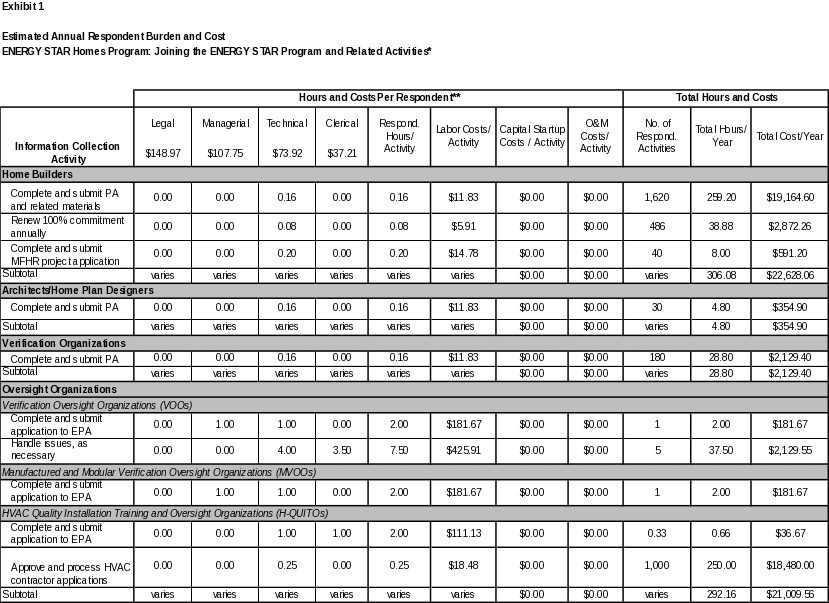
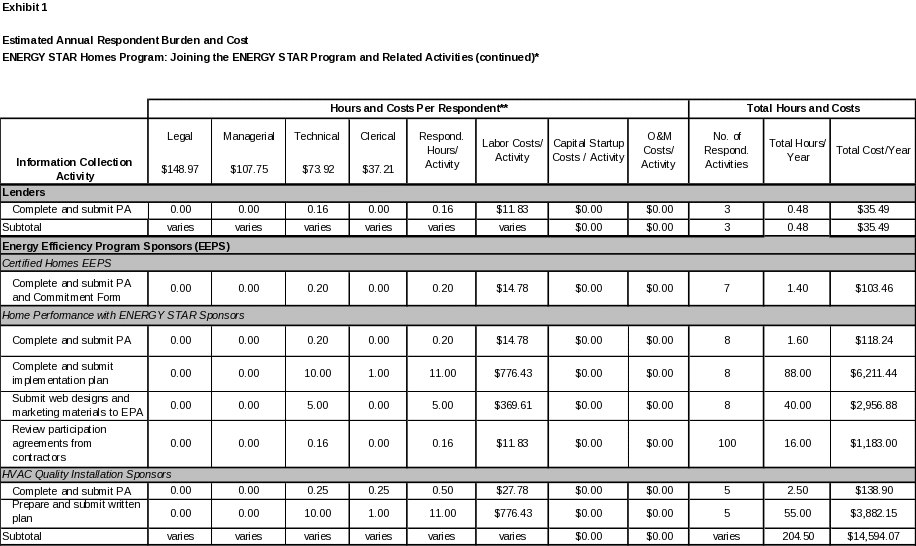
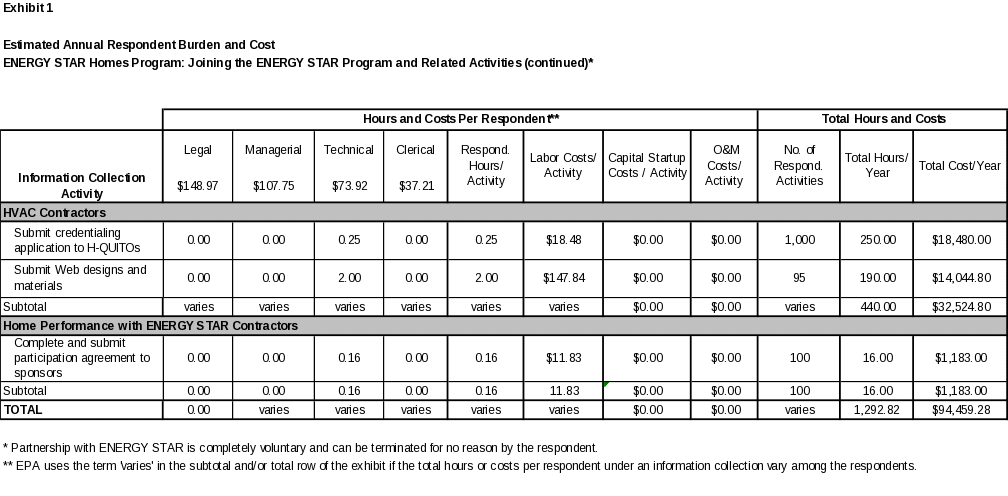
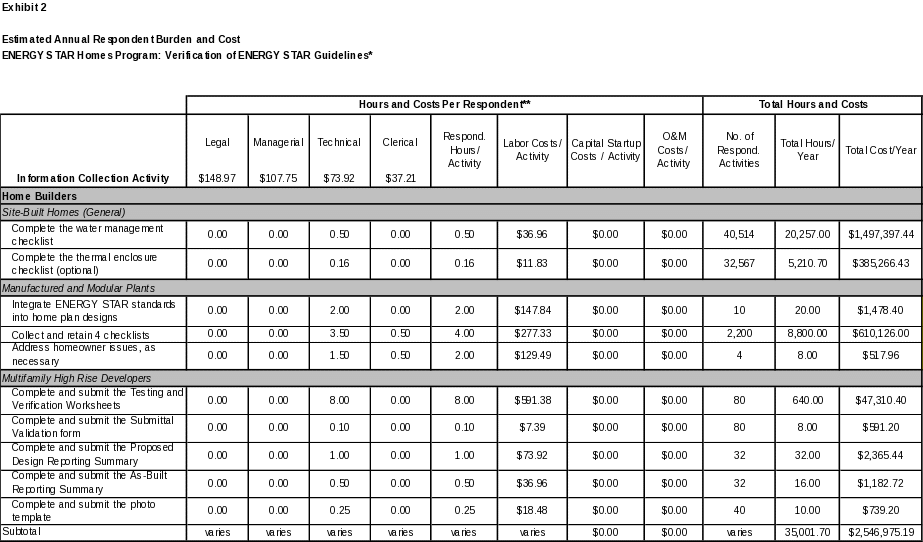
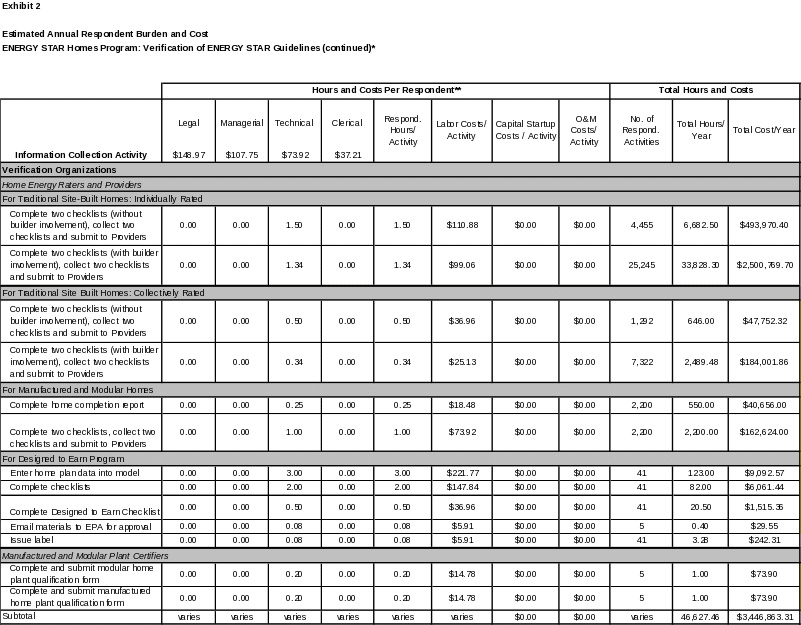
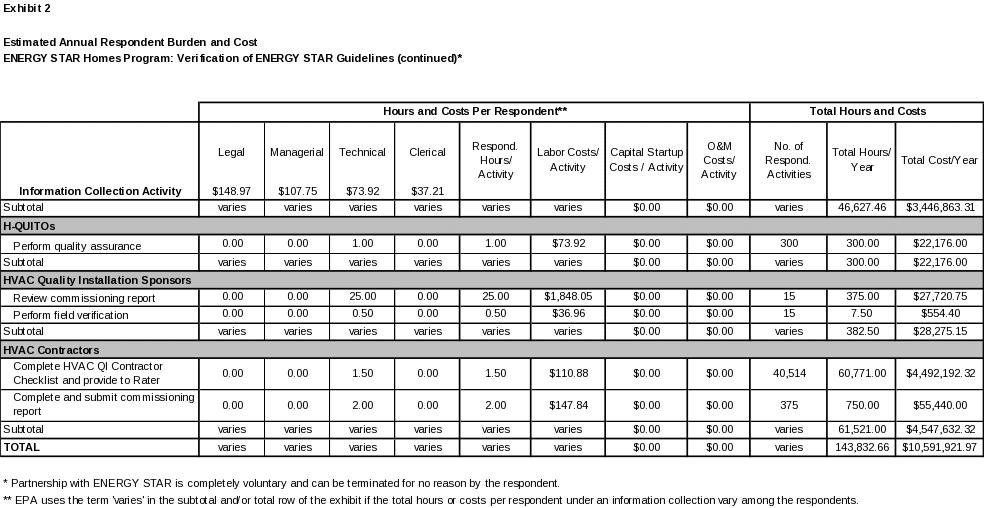
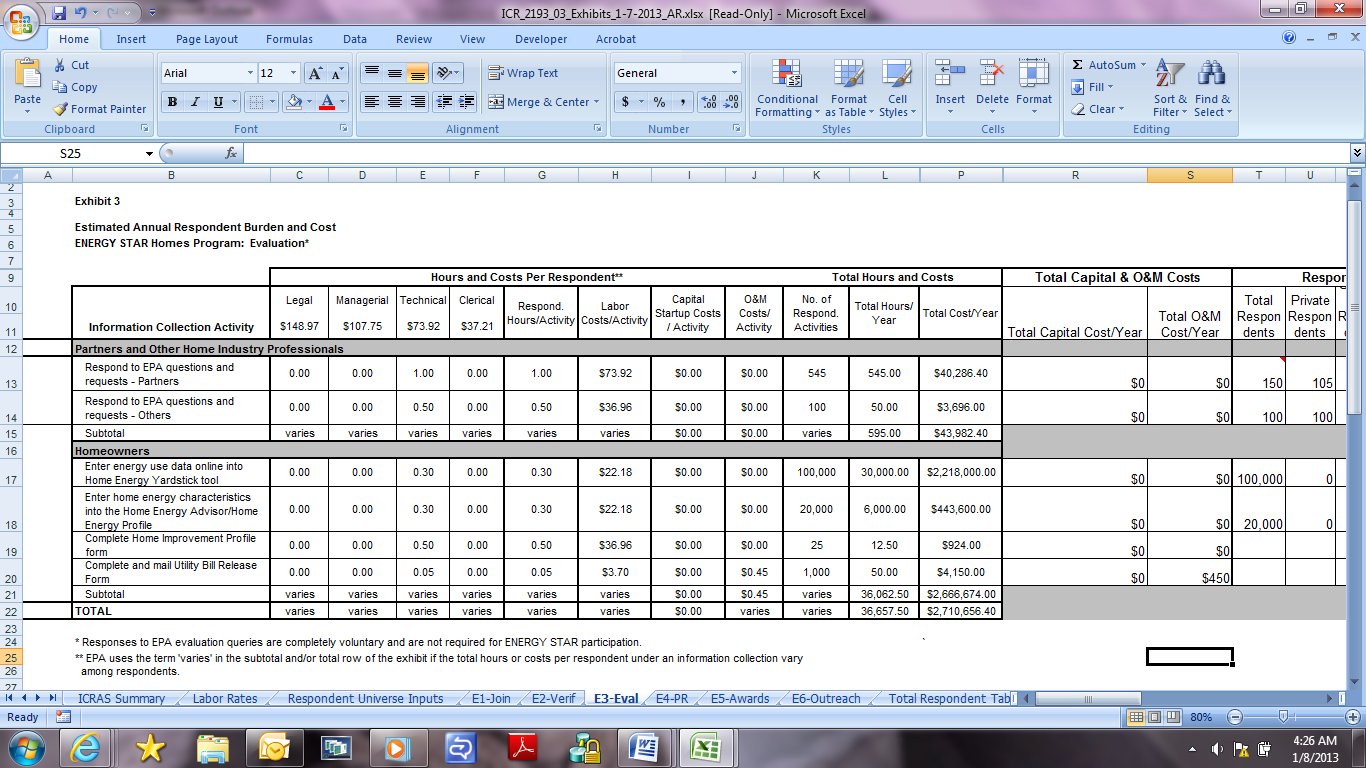
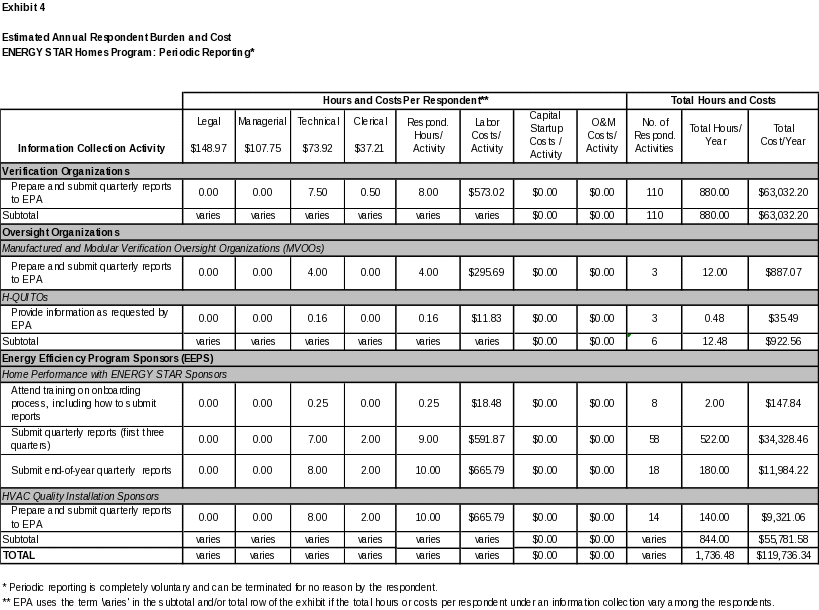
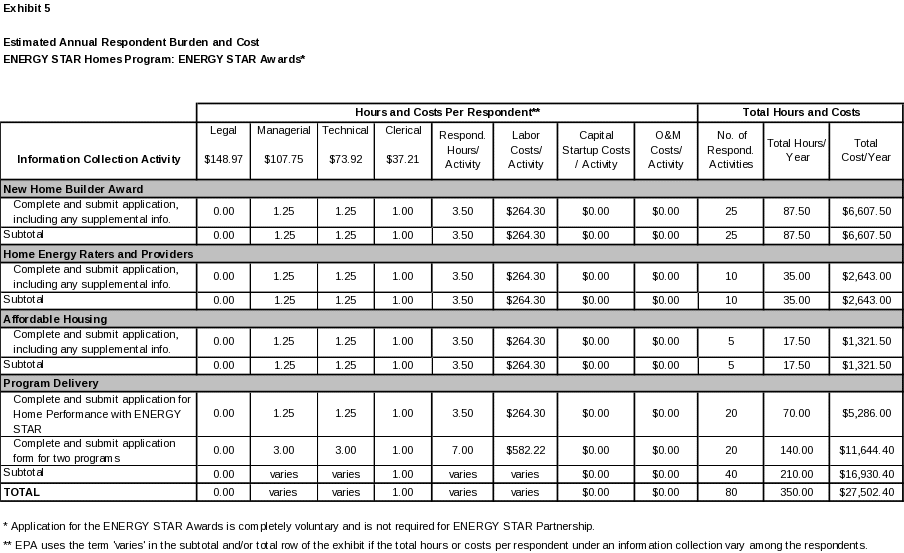
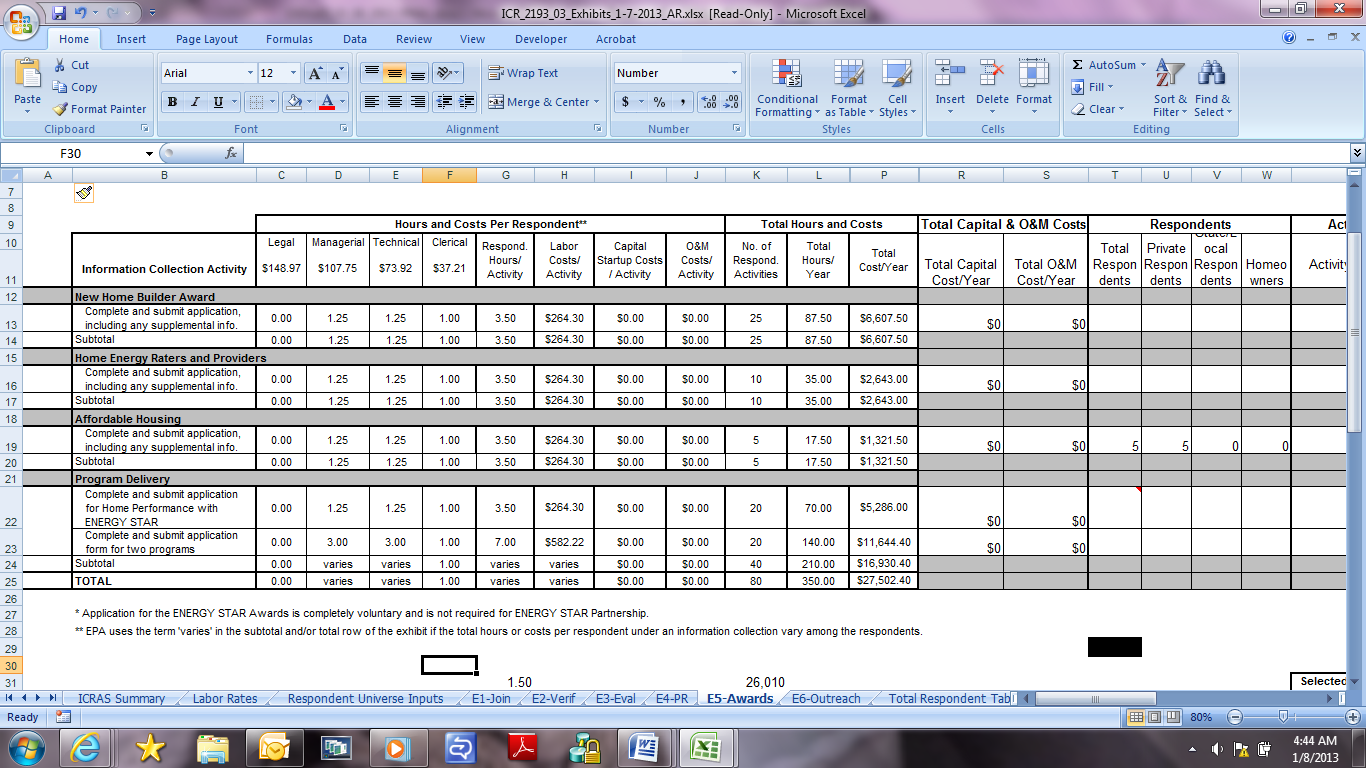
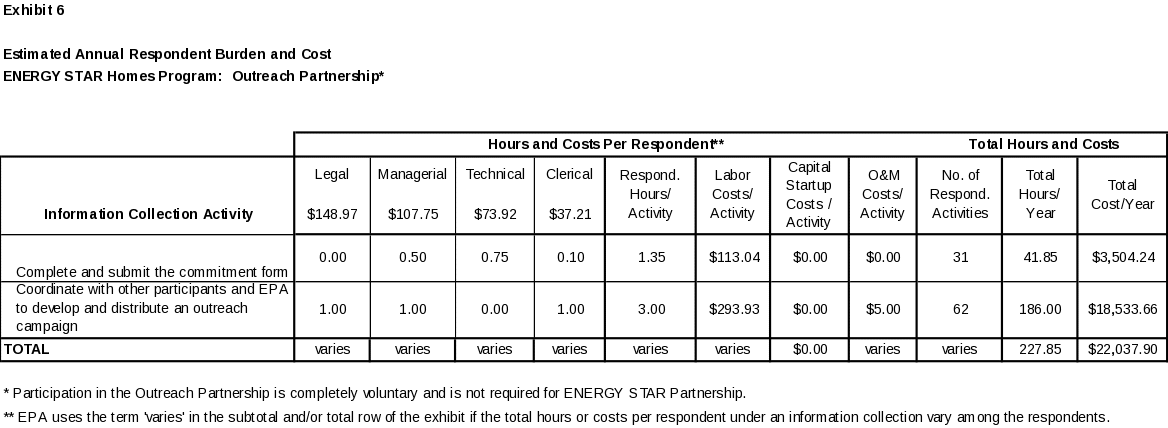
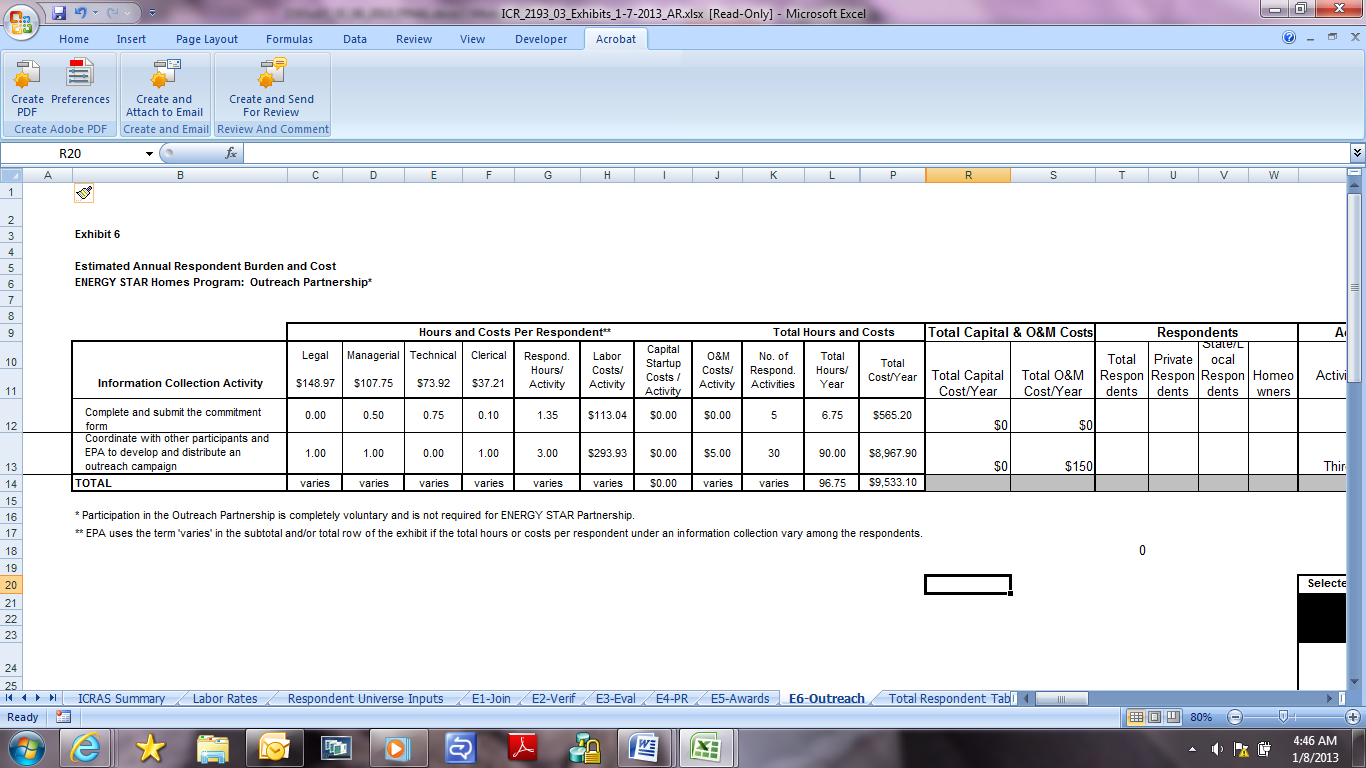
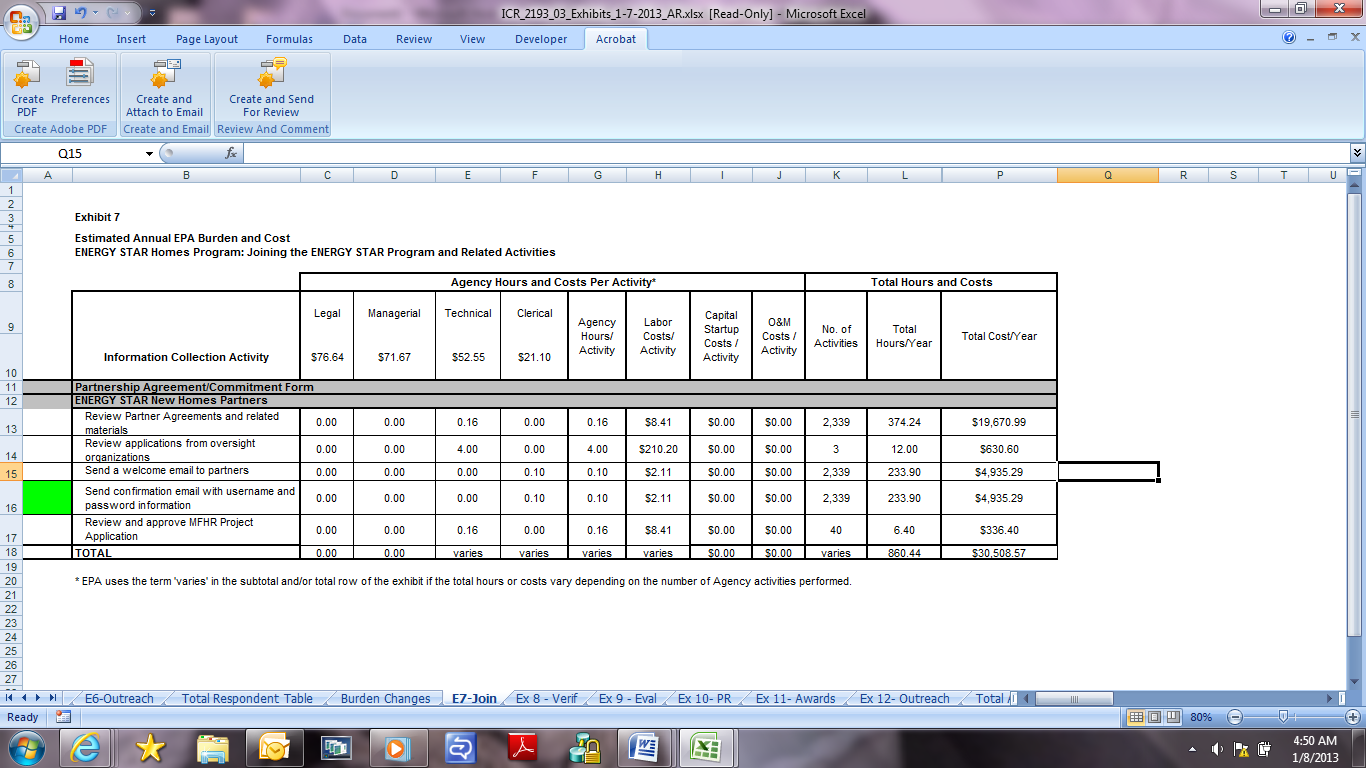
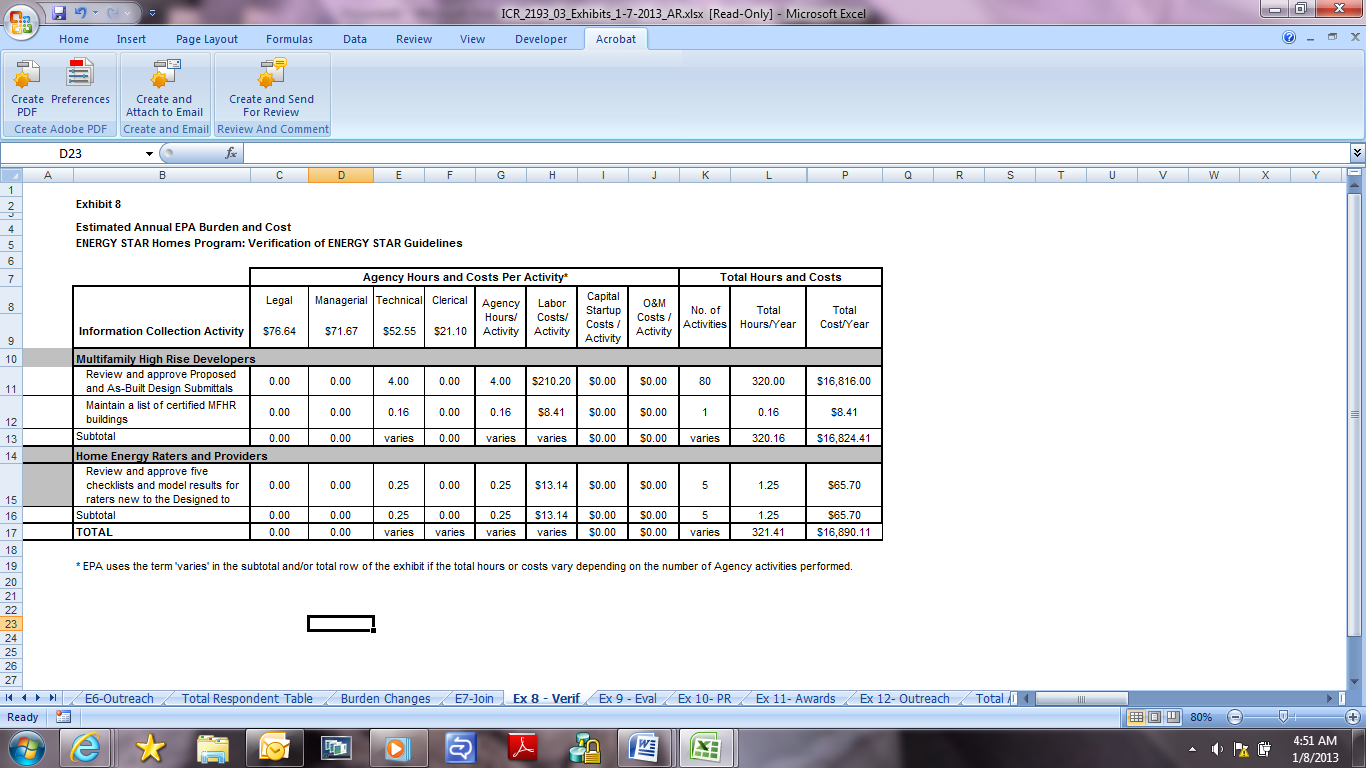
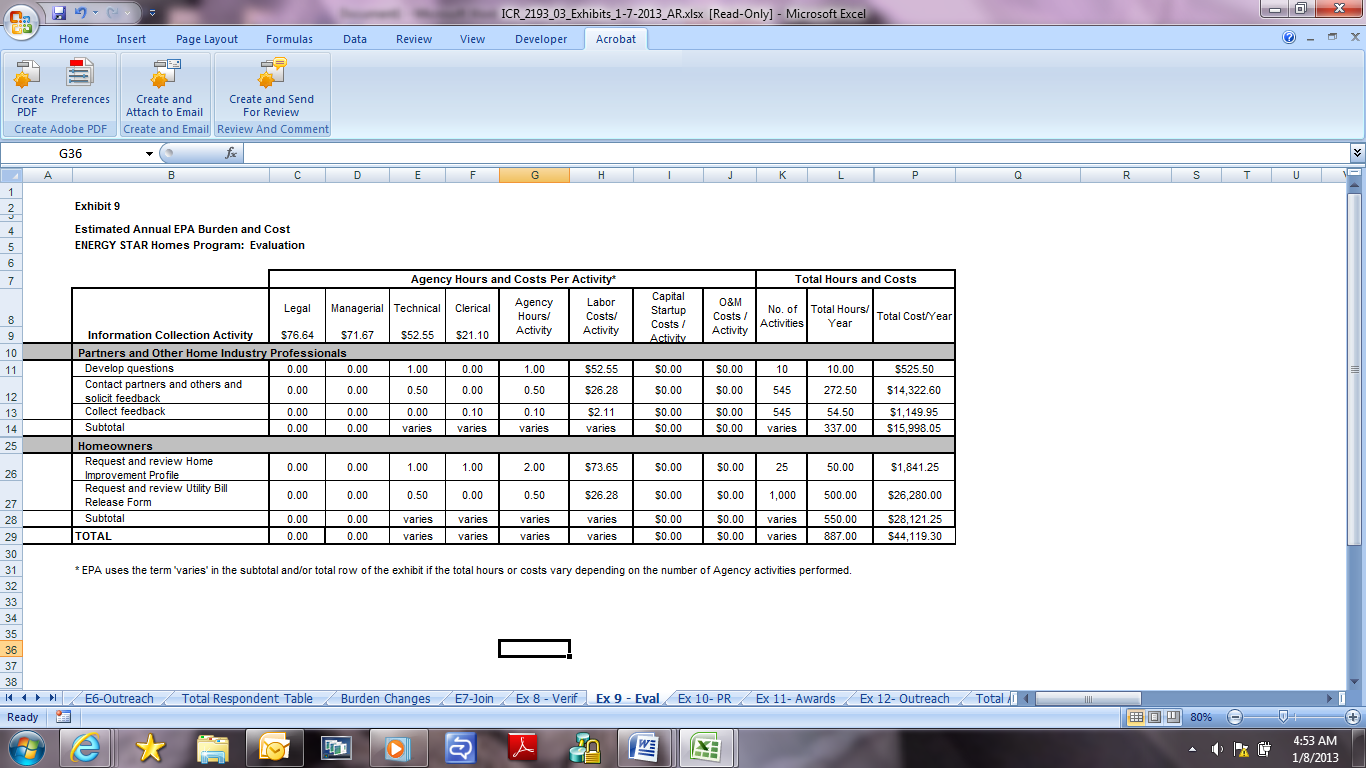
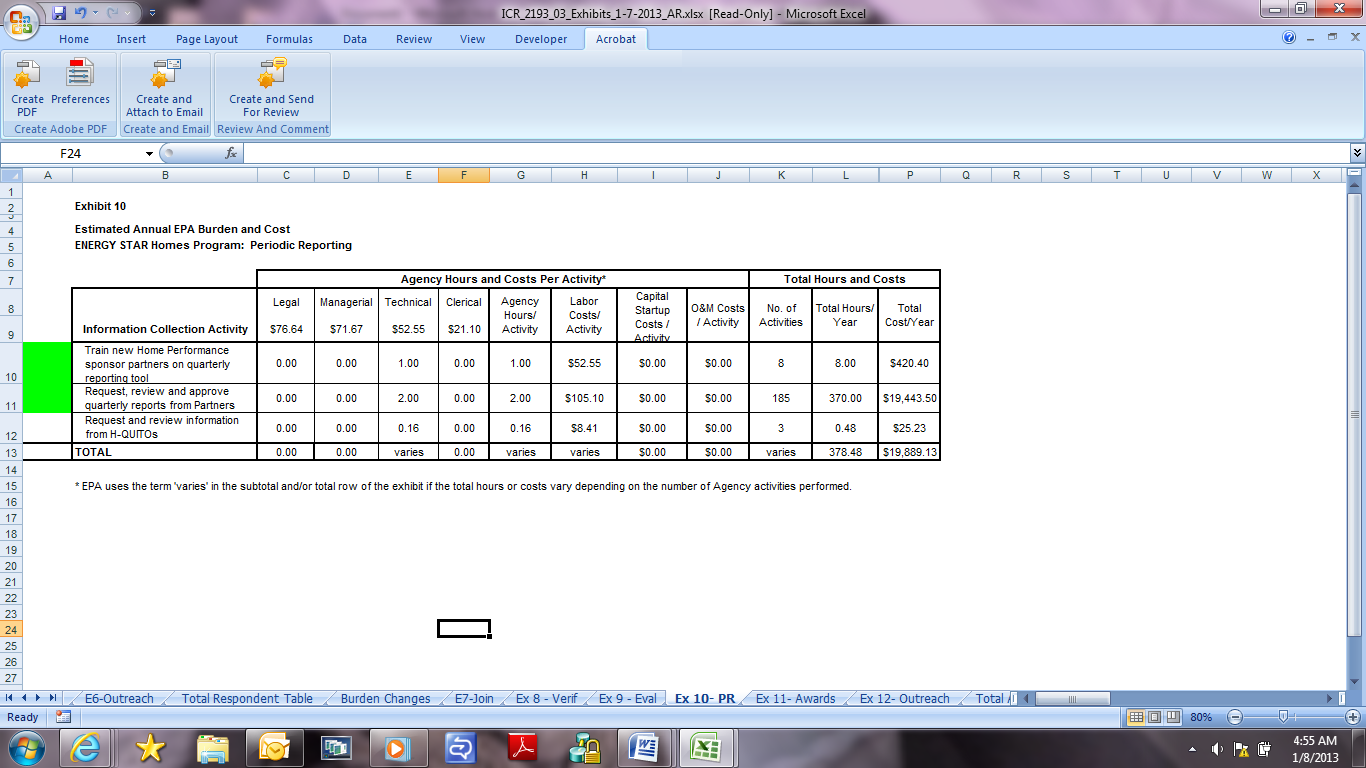
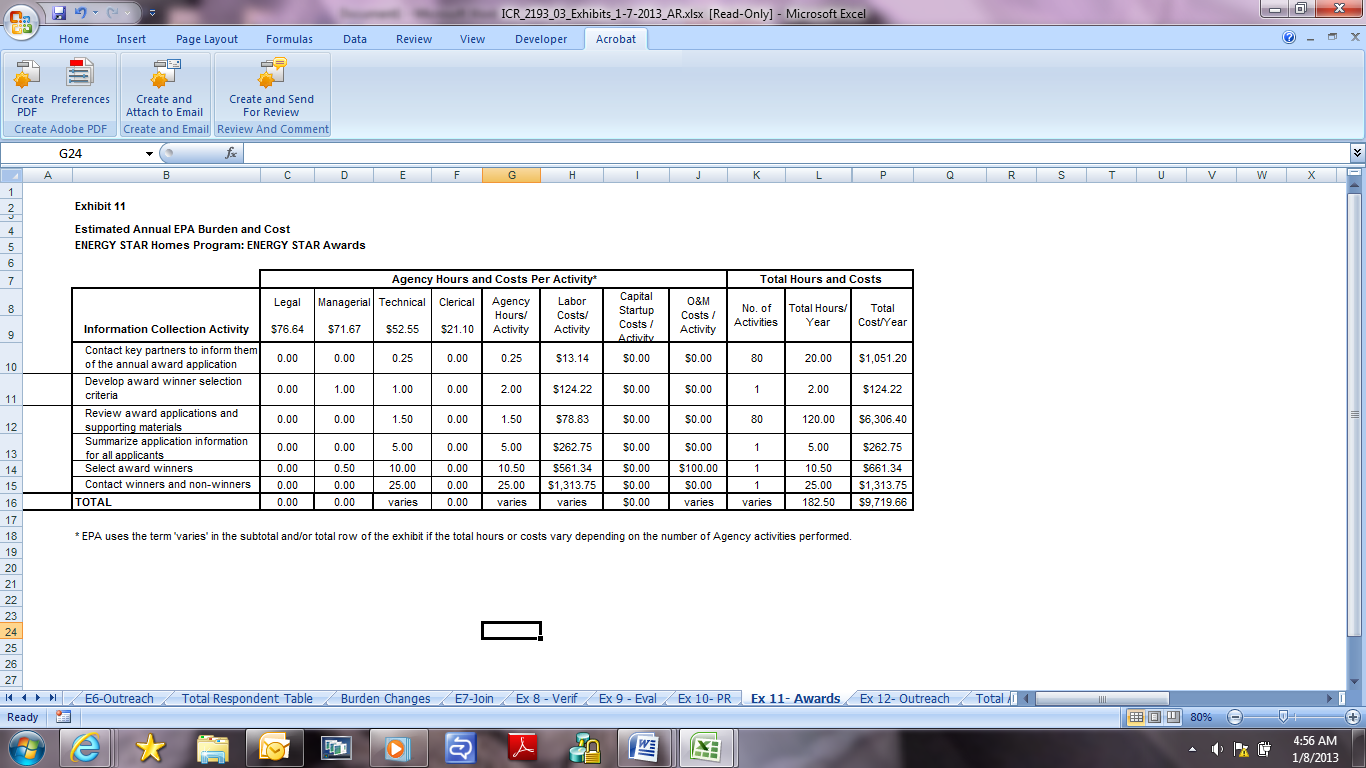
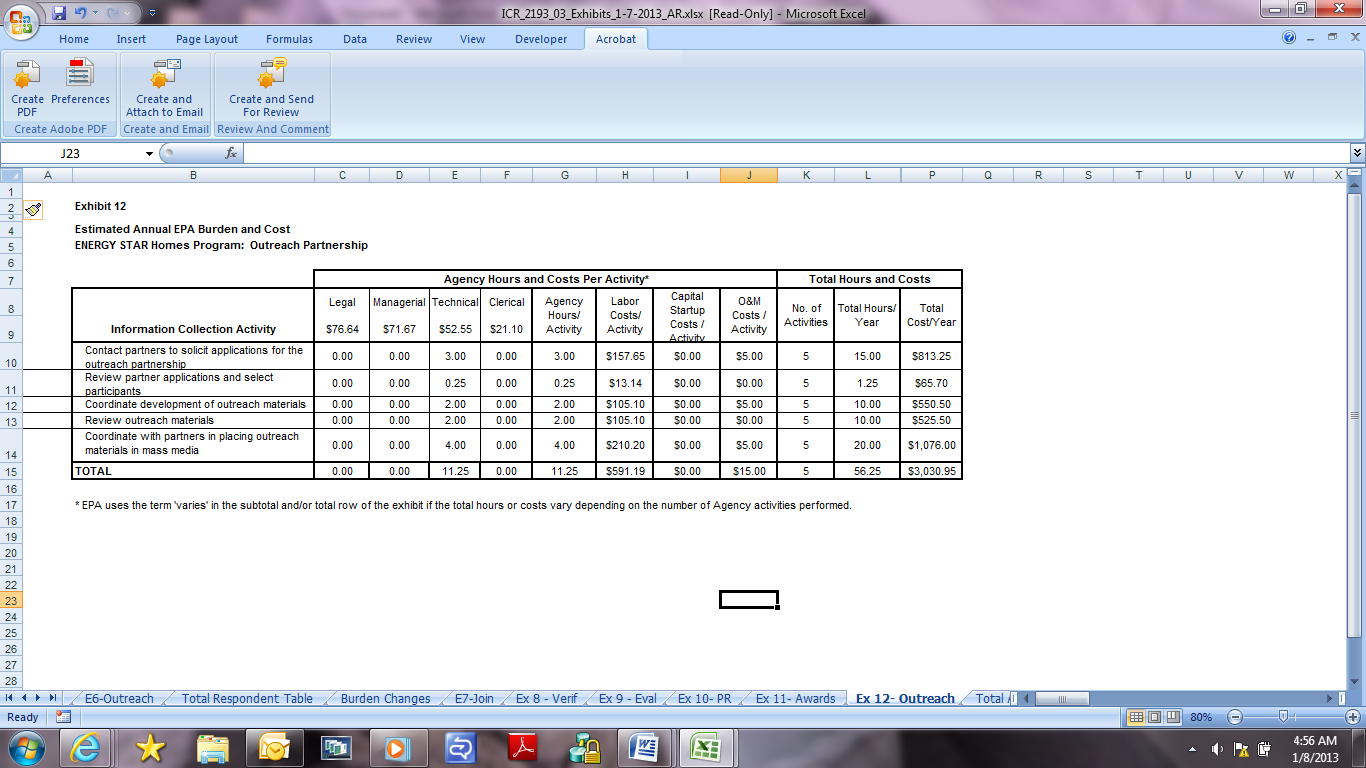
6(e) Bottom Line Burden Hours and Cost Tables
(i) Respondent Tally
As shown in Table 3, EPA estimates the total annual burden to respondents to be 183,967 hours and $13,553,809. The total bottom-line burden to respondents over three years is estimated to be 551,901 hours and $40,661,427.
Table 3. Total Estimated Respondent Burden and Cost Summary *
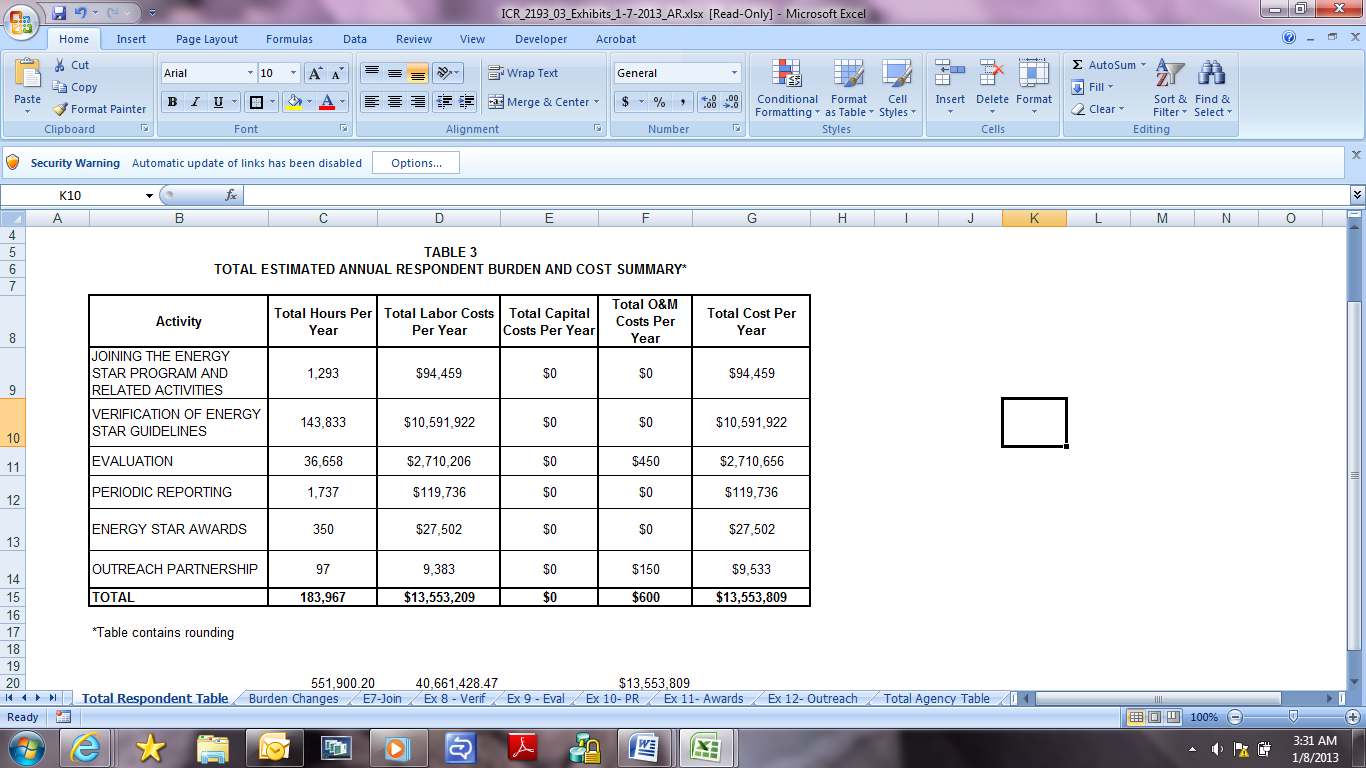
*Exhibit contains rounding.
(ii) Agency Tally
As shown in Table 4, EPA estimates the total annual burden to the Agency to be 2,686 hours and $124,158. The bottom-line burden to the Agency over three years is estimated to be 8,058 hours and $372,474.
Table 4. Total Estimated Agency Burden and Cost Summary *
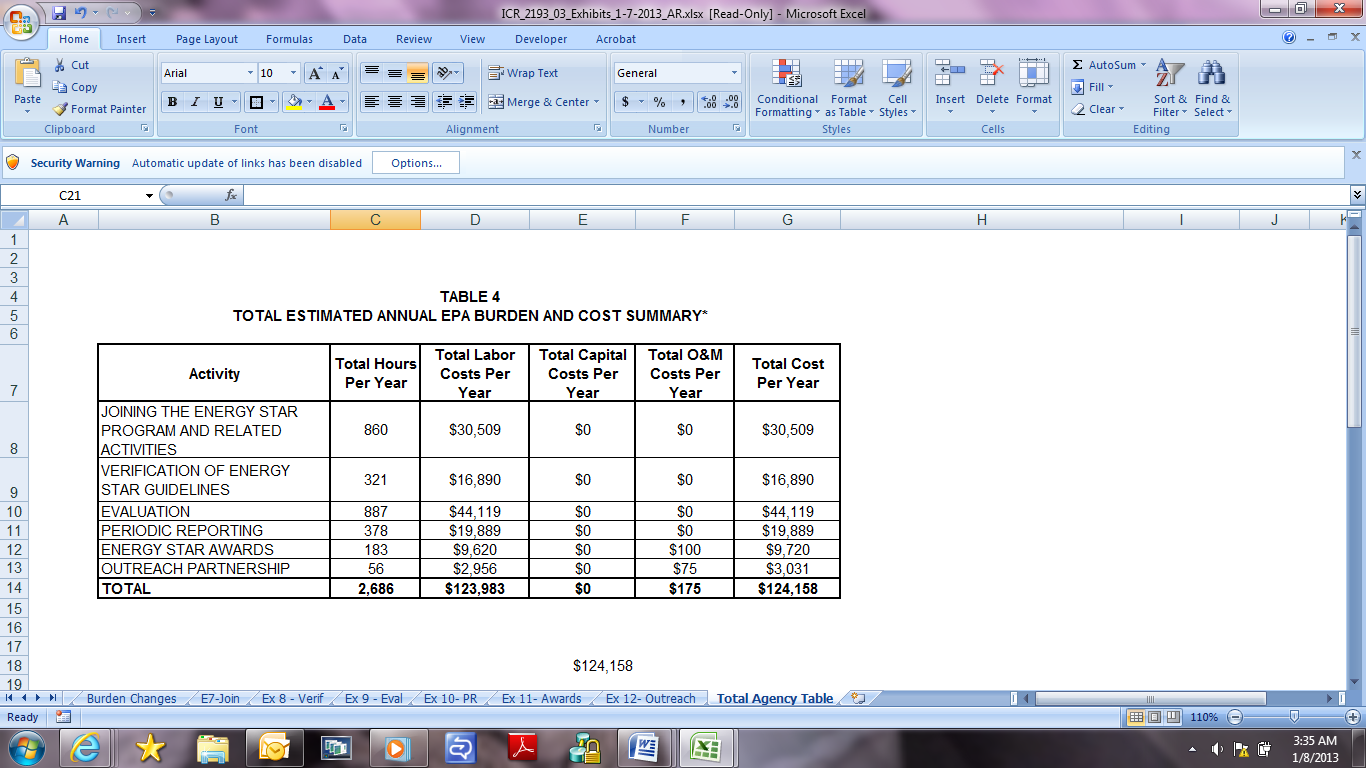
*Exhibit contains rounding.
6(f) Reasons for Change in Burden
EPA estimates a total annual respondent burden in this ICR, 2193.03, of 183,967 hours. This is an increase of 3,009 hours from the previously approved burden of 180,958 hours in ICR 2193.02.
Table 5 explains this 3,009-hour increase. Specifically, the table presents the total annual hours estimated in ICR 2193.02 and ICR 2193.03 for each category of collections in this document (see columns 1-3). The table then compares their respective hours to derive the change in hours and indicates whether this hour-change resulted from a program change and/or adjustment (see column 4). The table also briefly describes the program change and/or adjustment (see column 5). Finally, the table sums up all hour-changes to derive the total annual change in hours for all collections (see the bottom row of the table).
The table shows that there was a 112,566-hour increase due to program changes and a 109,557-hour decrease due to adjustments resulting primarily from improved data and analysis. This resulted in a net increase of 3,009 hours in ICR 2193.03.
The table shows that verification of ENERGY STAR guidelines (Exhibit 2) experienced the largest burden increase due to program changes. Specifically, this increase resulted primarily from EPA’s new, more rigorous guidelines for new homes looking to earn the ENERGY STAR. Compared to homes built to the prior guidelines, homes built to the new guidelines are at least 10 percent more energy efficient. As part of these new guidelines, EPA is asking verification organizations to use four checklists (of which 3 are new) that are necessary for ensuring that critical details and systems that impact a home’s efficiency, comfort, and durability are not missed or installed incorrectly during the design and construction phases.
The table shows that verification of ENERGY STAR guidelines also experienced the largest burden decrease due to adjustments. Reasons for this decrease include the following:
EPA refined its analysis in ICR 2193.03 to more accurately account for the fact that the majority of site-built homes represent production homes, of which those that have the same floor plan, equipment and other characteristics will be verified collectively using an analytical protocol developed by the rating industry. In the collective rating protocol, one in seven homes can be verified using the checklists. As such, collective ratings streamline the burden on industry in comparison with individual home ratings. ICR 2193.02 did not fully account for the burden-savings of collective ratings. This has been addressed in ICR 2193.03.
The U.S. Office of Management and Budget (OMB) regulations at 5 CFR 1320.3 provide that the time, effort, and financial resources necessary to comply with a collection of information that would be incurred by persons in the normal course of their activities (e.g., in compiling and maintaining business records) is excluded from the definition of “burden.” In accordance with this provision, ICR 2193.03 more accurately accounts for ENERGY STAR collections that involve usual and customary business practices. For example, home energy ratings are normally performed according to accepted industry standards that have been developed and are followed independently of ENERGY STAR through standards including the RESNET Mortgage Industry national Home Energy Rating Standards. Please see RESNET's web page (http://www.resnet.us/professional/standards), which discuss that RESNET's standards set the national procedures for home energy ratings. The ENERGY STAR Program adds a layer of quality assurance and sets efficiency requirements to supplement these industry standards and activities. In addition, utilities that implement home performance and HVAC quality installation programs normally have relationships with their contractors, regardless of whether the program is implemented in connection with ENERGY STAR or not. Many of the collections performed under such programs are usual and customary practices, such as preparing test out reports. In this respect, EPA refined the burden estimates in ICR 2193.03 to account solely for the burden associated with the ENERGY STAR Program and exclude usual and customary business practices.
EPA realizes that there is a learning curve associated with use of the processes and checklists under the ENERGY STAR Program. EPA believes that, over the past three years, respondents have become more familiar and adept in completing these processes and paperwork. ICR 2193.03 reflects this greater familiarization and ability to perform activities more efficiently.
In addition, the table shows a relatively significant burden increase due to adjustments for evaluations (Exhibit 3). This increase results primarily from EPA’s expectation of strong growth in homeowners’ use of online assessment tools like the Home Energy Yardstick and Home Energy Advisor. These tools greatly benefit homeowners in learning about and improving their homes’ energy efficiency.
Finally, EPA notes that ICR 2193.02 included an $800 capital cost for each manufactured and modular housing plant to modify and retool plant operations to become certified to produce homes that are ready for ENERGY STAR qualification. EPA believes that such costs are a usual and customary part of a plant’s business functions. Thefore, ICR 2193.03 does not include these costs. [Note: Table 5 does not examine these costs because it addresses only hour burden.]
EPA believes that the burdens estimated in this ICR are justified given the significant benefits to participants, the general public, and environment under the ENERGY STAR Program. Through the end of 2011, more than 1.3 million ENERGY STAR certified homes have been built in the U.S. and more than 150,000 have been retrofitted through Home Performance with ENERGY STAR Programs. This is the 20th anniversary of the ENERGY STAR Program. Over the past 20 years, with the help of ENERGY STAR, American families and businesses have saved about $230 billion on utility bills and prevented more than 1.7 billion metric tons of carbon pollution.
EPA believes collecting information from the public regarding ENERGY STAR in the residential sector is critical to the program’s sustained success in forming and nurturing voluntary agreements with the private sector to build and promote energy efficient homes. Partners view the ENERGY STAR label as a very effective marketing tool for highlighting the energy efficiency of their products, services, and homes to homebuyers and homeowners. In addition, ENERGY STAR provides partners with recognition as environmental leaders. Collecting information about partners and about ENERGY STAR’s impact in the residential marketplace is necessary to ensure that the value of the ENERGY STAR brand is protected and maintained, and to ensure continued success and delivery of valuable benefits to partners such as market differentiation, competitive advantage, and public recognition.
6(g) Burden Statement
For the private sector, the annual reporting and recordkeeping burden for this collection of information is estimated to average 55 minutes per response.
For states and locals, the annual reporting and recordkeeping burden for this collection of information is estimated to average 70 minutes per response.
For homeowners, the annual reporting and recordkeeping burden for this collection of information is estimated to average 18 minutes per response.
Burden means the total time, effort, or financial resources expended by persons to generate, maintain, retain, or disclose or provide information to or for a Federal agency. This includes the time needed to review instructions; develop, acquire, install, and utilize technology and systems for the purposes of collecting, validating, and verifying information, processing and maintaining information, and disclosing and providing information; adjust the existing ways to comply with any previously applicable instructions and requirements; train personnel to be able to respond to a collection of information; search data sources; complete and review the collection of information; and transmit or otherwise disclose the information.
To comment on the Agency's need for this information, the accuracy of the provided burden estimates, and any suggested methods for minimizing respondent burden, including the use of automated collection techniques, EPA has established a public docket for this ICR under Docket ID No. EPA-HQ-OAR-2004-0500, which is available for public viewing at the Air and Radiation Docket and Information Center in the EPA Docket Center (EPA/DC), EPA West, Room 3334, 1301 Constitution Ave., NW, Washington, DC. The EPA Docket Center Public Reading Room is open from 8:30 a.m. to 4:30 p.m., Monday through Friday, excluding legal holidays. The telephone number for the Reading Room is (202) 566-1744, and the telephone number for the Air and Radiation Docket and Information Center is (202) 566-1742. An electronic version of the public docket is available through the Federal Docket Management System (FDMS) at http://www.regulations.gov. Use FDMS to submit or view public comments, access the index listing of the contents of the public docket, and to access those documents in the public docket that are available electronically. Once in the system, select "search," then key in the docket ID number identified above. Also, you can send comments to the Office of Information and Regulatory Affairs, Office of Management and Budget, 725 17th Street, NW, Washington, DC 20503, Attention: Desk Office for EPA. Please include the EPA Docket ID No. EPA-HQ-OAR-2004-0500 and OMB Control Number 2060-0586 in any correspondence.
| File Type | application/vnd.openxmlformats-officedocument.wordprocessingml.document |
| Author | Allegra & Brian Ng |
| File Modified | 0000-00-00 |
| File Created | 2021-01-29 |
© 2025 OMB.report | Privacy Policy
